Product Categories
SHOP BY ARTIST
NEWSLETTER
Products
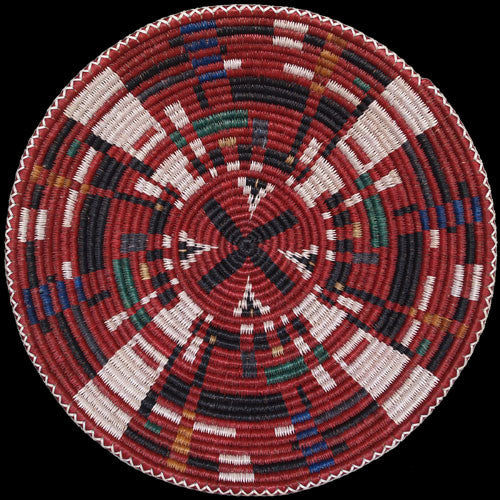
Navajo Memorial Day Basket - Joann Johnson (#111)
$1,995.00
Artist: Joann Johnson
Navajo Baskets
16" x 2 1/4" deep
Rounds: 30
The manner in which Navajo basket weaver, Joann Johnson, weaves light and color into her textiles is, simply, amazing. We believe Joann sees the world in a whole different manner than anyone else. The cool thing about that is she can share her vision with the rest of us through her baskets. Stand back and take a look, then tell us if your perspective is not positively affected.
We offer a 100% satisfaction guarantee on every purchase.
About the artist:

A fourth generation Navajo basket weaver, Joann Johnson has a passionate awareness of her heritage and history. Born and raised in Monument Valley, she has spent her life in the Navajo heartland, surrounded by the sacred mountains and monuments that tell the stories of her people's past.
Related legends:
Navajo Basketry
Basketry is a woman's industry, which is also pursued by the nadle (he changes), hermaphrodites, or men skilled in the arts and industries of both men and women. Basketry, however, is not classified with textile fabrics (yistl'o), but with sewing (nalkhad). It is of interest also that, while the basket is in progress, the sewer is untouched and avoided by the members of her family?
Wickerwork
The carrying basket is even less frequently seen than the water jar. tsizis (tsi, hair, and zis, or azis, a bag or pouch, from the mode of carrying it over the hair of the forehead) is used at present for gathering the hashkan, or yucca fruit, for syrup. The baskets are plaited of willow twigs much after the style of our own baskets, but have neither handle nor finished rim? More about this legend

Navajo Midnight Storm Pattern Weaving - Gabriel Benally (#18)
$1,875.00
Artist: Gabriel Benally
65" x 48"
Storm pattern weavings are striking in their power and graphics, and Navajo rug weaver Gabriel Benally knows how to channel the imagery. Gabriel loves to weave, and his rugs are precise and finished. Because of the black background, this one is referred to as a Midnight Storm. Gabe is great.
About the artist:

Related legends:
Storm Rugs
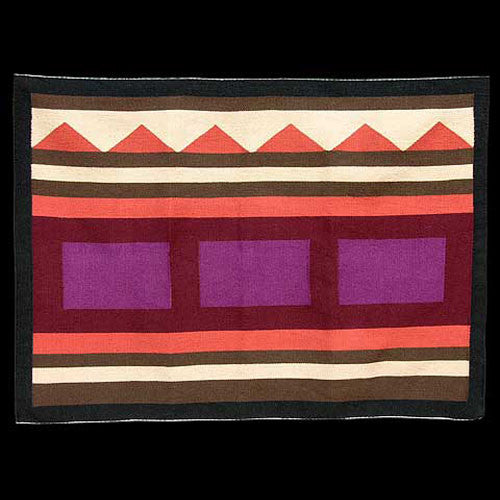
Navajo Modern Twin Rocks "Journey" Rug - Eleanor Yazzie (#042)
$2,050.00
Artist: Eleanor Yazzie
We offer a 100% satisfaction guarantee on every purchase.
About the artist:

Eleanor was born in 1963 at Keams Canyon, Arizona to Joe and Ella Benally. She has two sisters and five brothers. When visiting her grandmother on her mother's side who lived at Smoke Signal, she would watch her weave. Her grandmother, Bah Begay, especially loved weaving storm pattern rugs. Eleanor helped her grandmother who, at that time, made handspun rugs. Eleanor learned every step from shearing the sheep to washing and dyeing the wool to spinning the yarn. Because her grandmother especially loved the storm pattern weavings, this style was the first type woven by Eleanor. Her mastery of complex geometrics and diagonal lines comes from this experience in weaving the storm pattern.
See full biographyRelated legends:
Weaving
After the medicine woman told the people about the prayersticks she told them that there was a place in the underworld where two rivers crossed. It was called ni tqin'kae tsosi, fine fiber cotton (Indian hemp). There were two persons who brought the seed of that plant, they were spiders. They said that the people were to use the plant instead of skins for their clothing. So this seed was planted in the earth? More about this legend
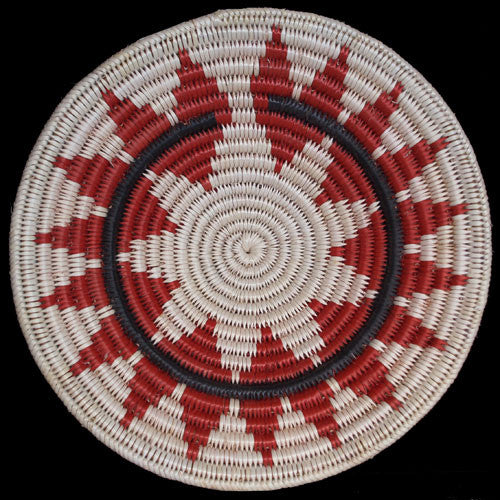
Navajo Modified Ceremonial Basket - Evelyn Cly (#184)
$250.00
Artist: Evelyn Cly
Navajo Basketry
11 1/2" x 1 1/2" deep
Rounds: 17
We offer a 100% satisfaction guarantee on every purchase.
About the artist:

Evelyn's baskets are known for their extremely tight weave and open geometric designs. Perhaps the best indicator of how valuable her baskets are is that different traders have her baskets in their private collections.
Related legends:
Navajo Ceremonial Baskets
The Navajo wedding basket also reflects many values of traditional life and so often contains all six sacred mountains, including Huerfano and Gobernador Knob, though the size of the basket may determine the numher of mountains in the design. The center spot in the basket represents the beginning of this world, where the Navajo people emerged from a reed? More about this legend

Navajo Modified Ganado Weaving - Louise Harvey (#03)
$2,400.00
Artist: Louise Harvey
43" x 71"
A "modified" designation in Navajo rug weaving terminology refers to a pattern that is similar to one of the more notable designs, but varies in unique and remarkable ways. In this case Louise Harvey has taken the red background from the Ganado pattern and adapted the geometric designs into something that is pleasing to her. Many weavers get stuck in a rut, producing patterns of a singular style with variations of color only. Louise, however, is one of the few weavers who throws caution to the wind and creates something new and innovative almost every time. What kind of fun is that? "Great fun", says Louise.
Related legends:
Weaving
After the medicine woman told the people about the prayersticks she told them that there was a place in the underworld where two rivers crossed. It was called ni tqin'kae tsosi, fine fiber cotton (Indian hemp). There were two persons who brought the seed of that plant, they were spiders. They said that the people were to use the plant instead of skins for their clothing. So this seed was planted in the earth? More about this legend

Navajo Monument Valley or Bust Basket - Lorraine Black (#232)
$3,750.00
Artist: Lorraine Black
Navajo Basket
20" x 3 1/4" deep
Rounds: 36
Monument Valley or bust! That seems to be the theme of numerous gangs of motorcyclists these days. Here at Twin Rocks we see motorcycle mamas and papas by the score and so must Lorraine Black. Lorraine was so impressed by the throngs of Harley's and the like that she expressed her amazement through her art. Lorraine's fine weave and unique overstitch technique help her create the most amazing and unique baskets ever.
We offer a 100% satisfaction guarantee on every purchase.
About the artist:

Inspired by dreams, Lorraine Black's skills have literally elevated basket weaving to new dimensions. Lorraine Black's infectious laugh belies the serious magic her hands conjure up when weaving a basket. Unprecedented in her ideas, Lorraine's baskets are innovative and beautiful. Many of them make good use of texture through over-stitching and the addition of objects such as flint arrowheads or horsehair.
Related legends:
Navajo Basketry
Basketry is a woman's industry, which is also pursued by the nadle (he changes), hermaphrodites, or men skilled in the arts and industries of both men and women. Basketry, however, is not classified with textile fabrics (yistl'o), but with sewing (nalkhad). It is of interest also that, while the basket is in progress, the sewer is untouched and avoided by the members of her family?

Navajo Morenci Turquoise Bracelet - Derrik Gordon (#05)
$875.00
Artist: Derrik Gordon
Navajo Jewelry
Total Circumference: 6 3/8"
Inner Circumference: 5 3/8"
Opening: 1"
Heavy duty silver sheet, well laid out and deeply impressed stamp work, appropriate applique and top-notch turquoise placed in the hands of a master silver smith are key elements to producing high quality American Indian jewelry. Derrick Gordon is just the man for the job and he has, indeed, created a most wonderful wrist cuff. Morenci turquoise is one of the classics and Derrick is fast becoming recognized as an artist to be reckoned with when it comes to Navajo jewelry. Stick with the best, you will never regret it.
We offer a 100% satisfaction guarantee on every purchase.
Morenci Turquoise; Arizona Mine, Morenci, Clifton-Morenci District, Shannon Mountains, Greenlee County, Arizona, USA. An open pit copper mine located in the N1⁄2 Section 16, T4S, R29E (Clifton 15 minute topographic map), owned by Phelps Dodge Corp. Map Reference: 33°5'26"N, 109°21'58"W.
Morenci turquoise was mined in southeastern Arizona until approximately 1990. It is located very near the New Mexico border, and ranges in color from classic high electric blue to light azure. Prehistoric Indians who valued the stone for its deep blue color were the first to discover the deposit. These people adorned themselves with rough-hewn beads and carved talisman made from the mineral
Morenci is often associated with an unusual black matrix of irregular iron pyrite, which looks metallic when polished. Although they are rare, stones with unusual birds-eye patterns, red matrix and an occasional layer of silver have also been found. The Morenci name is derived from the large open pit copper mine owned and operated by the Phelps Dodge Corporation. Early examples of this striking turquoise were of the "lunch box" variety, meaning workers and miners carried them out of the mine.
Morenci is well known; it was one of the first types of American turquoise to find its way to the market and is always difficult to obtain because the mine was depleted so long ago. It is believed that the best Morenci ever produced was discovered in the late 1960's to early 70's. During this time period, the mine produced a high, electric blue variety with iron pyrite inclusions. Since Morenci is no longer being mined, and because of its striking color and unusual matrix combinations, high grade natural Morenci is a valuable, highly collectible mineral.
USGS; Arizona.--In Arizona turquoise ranks first in terms of value of production and is also the best known of its gem materials. Nearly all-important deposits of turquoise are located near copper occurrences or in copper deposits in arid desert regions of the world. Thus, the world famous turquoise deposits associated with certain of the large Arizona copper deposits are to be expected.
Turquoise is, or has been, mined from a number of these copper mines as a byproduct, usually by outside contractors. The financial and operating terms of the collecting contracts vary from mine to mine. Some of the operations are little more than the efforts of individual commercial collectors; some are essentially full-scale mining operations that are simultaneous with, but separate from, the regular mining operations; and still others operate on an on-call basis as turquoise is uncovered by the regular copper mining operation. Regardless of the size or sophistication of the initial mining or recovery operation, the actual turquoise is recovered by careful extraction using hand method.
About the artist:
At the age of nineteen, Derrick Gordon sat down at the bench with his uncle, Delbert Gordon, and a promising new career was launched. Derrick was born and raised in Gallup, New Mexico. He came into this world in 1971, but it was not until 1990 that he began to bless us with his unique style of Navajo silver jewelry.
Related legends:
Silversmith Work
When and how the Navajo acquired the art of working metals is unknown but there are reasons for supposing that it was introduced among them, or at least more developed and improved upon by them, since the time they have occupied their present country?
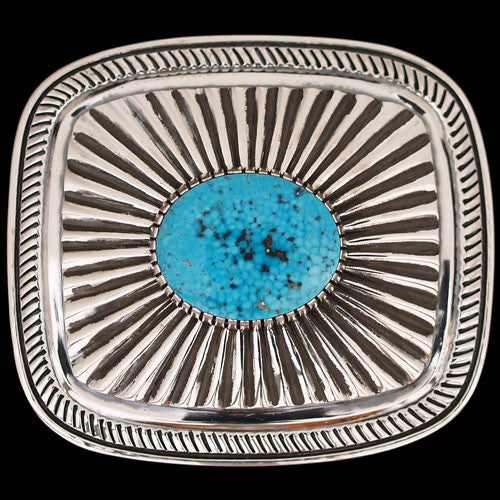
Navajo Morenci Turquoise Buckle - Allison Lee (#169)
$1,485.00
Artist: Allison Lee
Navajo Jewelry
2 1/2" x 2 1/4"
Allison Lee is surely one of the finest contemporary Navajo silversmiths working in the Southwest, likely the country. This immaculately conceived and exquisitely executed buckle shows off Allison’s skill. Wear this one dressed up or dressed down, just wear it. You will never be sorry you did.
We offer a 100% satisfaction guarantee on every purchase.
Morenci Turquoise
Morenci Turquoise; Arizona Mine, Morenci, Clifton-Morenci District, Shannon Mountains, Greenlee County, Arizona, USA. An open pit copper mine located in the N1⁄2 Section 16, T4S, R29E (Clifton 15 minute topographic map), owned by Phelps Dodge Corp. Map Reference: 33°5'26"N, 109°21'58"W.
Morenci turquoise was mined in southeastern Arizona until approximately 1990. It is located very near the New Mexico border, and ranges in color from classic high electric blue to light azure. Prehistoric Indians who valued the stone for its deep blue color were the first to discover the deposit. These people adorned themselves with rough-hewn beads and carved talisman made from the mineral
Morenci is often associated with an unusual black matrix of irregular iron pyrite, which looks metallic when polished. Although they are rare, stones with unusual birds-eye patterns, red matrix and an occasional layer of silver have also been found. The Morenci name is derived from the large open pit copper mine owned and operated by the Phelps Dodge Corporation. Early examples of this striking turquoise were of the "lunch box" variety, meaning workers and miners carried them out of the mine.
Morenci is well known; it was one of the first types of American turquoise to find its way to the market and is always difficult to obtain because the mine was depleted so long ago. It is believed that the best Morenci ever produced was discovered in the late 1960's to early 70's. During this time period, the mine produced a high, electric blue variety with iron pyrite inclusions. Since Morenci is no longer being mined, and because of its striking color and unusual matrix combinations, high grade natural Morenci is a valuable, highly collectible mineral.
USGS; Arizona.--In Arizona turquoise ranks first in terms of value of production and is also the best known of its gem materials. Nearly all-important deposits of turquoise are located near copper occurrences or in copper deposits in arid desert regions of the world. Thus, the world famous turquoise deposits associated with certain of the large Arizona copper deposits are to be expected.
Turquoise is, or has been, mined from a number of these copper mines as a byproduct, usually by outside contractors. The financial and operating terms of the collecting contracts vary from mine to mine. Some of the operations are little more than the efforts of individual commercial collectors; some are essentially full-scale mining operations that are simultaneous with, but separate from, the regular mining operations; and still others operate on an on-call basis as turquoise is uncovered by the regular copper mining operation. Regardless of the size or sophistication of the initial mining or recovery operation, the actual turquoise is recovered by careful extraction using hand method.
About the artist:

Allison Lee - Navajo Silversmith:
Speaking of the silver and gold jewelry he hand crafts, Allison Lee's captivating voice is sincere when he says, "One time my uncle told me that everything we build comes from the earth, like the silver that comes from the earth, or the turquoise that comes from the earth. That is a lot of energy. You put it together and you put your heart and mind into a piece. Then sometimes a certain piece of jewelry- I believe- it is made for a certain person. I usually have a ring, or something, that stays with me for about two or three years, until the right person comes along. And then that person buys that piece. I believe that every piece of jewelry that I make is made for somebody out there- it's made for somebody special. Whoever might be having problems, or something like that. In essence, that energy helps that person get help, by wearing pieces that we make. That is the way I look at it.
Related legends:
Precious Stones
Turquoise; Precious stones have symbolic implications. For example, turquoise if a "collective term for all the precious stones, wealth, or mixed offerings. Good fortune is attributed to this stone." Both white shell and turquoise are emphasized in Kinaalda? More about this legend

Navajo Morenci Turquoise Pendant - Derrick Gordon (#11)
$540.00
Artist: Derrick Gordon
Navajo Jewelry
1 1/4" x 2 1/4"
When we discovered this fabulous piece of high-grade natural Morenci turquoise it was set in a clunky old broach which had been made sometime in the 1960s. We were so impressed with the stone, and so unimpressed with the silver work of the broach, we separated them and started over. We gave the stone to Derrick Gordon and told him to have at it. The result is what you see before you now, a pendent, which perfectly sets off the classic stone. As you can see, the artistic choice was great.
We offer a 100% satisfaction guarantee on every purchase.
Morenci Turquoise
Morenci Turquoise; Arizona Mine, Morenci, Clifton-Morenci District, Shannon Mountains, Greenlee County, Arizona, USA. An open pit copper mine located in the N1⁄2 Section 16, T4S, R29E (Clifton 15 minute topographic map), owned by Phelps Dodge Corp. Map Reference: 33°5'26"N, 109°21'58"W.
Morenci turquoise was mined in southeastern Arizona until approximately 1990. It is located very near the New Mexico border, and ranges in color from classic high electric blue to light azure. Prehistoric Indians who valued the stone for its deep blue color were the first to discover the deposit. These people adorned themselves with rough-hewn beads and carved talisman made from the mineral
Morenci is often associated with an unusual black matrix of irregular iron pyrite, which looks metallic when polished. Although they are rare, stones with unusual birds-eye patterns, red matrix and an occasional layer of silver have also been found. The Morenci name is derived from the large open pit copper mine owned and operated by the Phelps Dodge Corporation. Early examples of this striking turquoise were of the "lunch box" variety, meaning workers and miners carried them out of the mine.
Morenci is well known; it was one of the first types of American turquoise to find its way to the market and is always difficult to obtain because the mine was depleted so long ago. It is believed that the best Morenci ever produced was discovered in the late 1960's to early 70's. During this time period, the mine produced a high, electric blue variety with iron pyrite inclusions. Since Morenci is no longer being mined, and because of its striking color and unusual matrix combinations, high grade natural Morenci is a valuable, highly collectible mineral.
USGS; Arizona.--In Arizona turquoise ranks first in terms of value of production and is also the best known of its gem materials. Nearly all-important deposits of turquoise are located near copper occurrences or in copper deposits in arid desert regions of the world. Thus, the world famous turquoise deposits associated with certain of the large Arizona copper deposits are to be expected.
Turquoise is, or has been, mined from a number of these copper mines as a byproduct, usually by outside contractors. The financial and operating terms of the collecting contracts vary from mine to mine. Some of the operations are little more than the efforts of individual commercial collectors; some are essentially full-scale mining operations that are simultaneous with, but separate from, the regular mining operations; and still others operate on an on-call basis as turquoise is uncovered by the regular copper mining operation. Regardless of the size or sophistication of the initial mining or recovery operation, the actual turquoise is recovered by careful extraction using hand method.
About the artist:
At the age of nineteen, Derrick Gordon sat down at the bench with his uncle, Delbert Gordon, and a promising new career was launched. Derrick was born and raised in Gallup, New Mexico. He came into this world in 1971, but it was not until 1990 that he began to bless us with his unique style of Navajo silver jewelry.
Related legends:
Silversmith Work
When and how the Navajo acquired the art of working metals is unknown but there are reasons for supposing that it was introduced among them, or at least more developed and improved upon by them, since the time they have occupied their present country?

Navajo Morenci Turquoise Pendant - Derrick Gordon (#13)
$520.00
Artist: Derrick Gordon
Navajo Jewelry
1 1/2" x 2 1/4"
Derrick Gordon has created an old, Keetoh, (bow guard), style pendant containing a marvelous cabochon of old Morenci Turquoise. The rough, high grade, natural turquoise was mined by the Brown family in the 1970's and set aside until recently. Bruce Eckhardt cut the turquoise into super nice cabochons, which were passed onto Derrick to build top quality Navajo jewelry. The process of creation was slow and meticulous but well worth the wait.
We offer a 100% satisfaction guarantee on every purchase.
Morenci Turquoise
Morenci Turquoise; Arizona Mine, Morenci, Clifton-Morenci District, Shannon Mountains, Greenlee County, Arizona, USA. An open pit copper mine located in the N1⁄2 Section 16, T4S, R29E (Clifton 15 minute topographic map), owned by Phelps Dodge Corp. Map Reference: 33°5'26"N, 109°21'58"W.
Morenci turquoise was mined in southeastern Arizona until approximately 1990. It is located very near the New Mexico border, and ranges in color from classic high electric blue to light azure. Prehistoric Indians who valued the stone for its deep blue color were the first to discover the deposit. These people adorned themselves with rough-hewn beads and carved talisman made from the mineral
Morenci is often associated with an unusual black matrix of irregular iron pyrite, which looks metallic when polished. Although they are rare, stones with unusual birds-eye patterns, red matrix and an occasional layer of silver have also been found. The Morenci name is derived from the large open pit copper mine owned and operated by the Phelps Dodge Corporation. Early examples of this striking turquoise were of the "lunch box" variety, meaning workers and miners carried them out of the mine.
Morenci is well known; it was one of the first types of American turquoise to find its way to the market and is always difficult to obtain because the mine was depleted so long ago. It is believed that the best Morenci ever produced was discovered in the late 1960's to early 70's. During this time period, the mine produced a high, electric blue variety with iron pyrite inclusions. Since Morenci is no longer being mined, and because of its striking color and unusual matrix combinations, high grade natural Morenci is a valuable, highly collectible mineral.
USGS; Arizona.--In Arizona turquoise ranks first in terms of value of production and is also the best known of its gem materials. Nearly all-important deposits of turquoise are located near copper occurrences or in copper deposits in arid desert regions of the world. Thus, the world famous turquoise deposits associated with certain of the large Arizona copper deposits are to be expected.
Turquoise is, or has been, mined from a number of these copper mines as a byproduct, usually by outside contractors. The financial and operating terms of the collecting contracts vary from mine to mine. Some of the operations are little more than the efforts of individual commercial collectors; some are essentially full-scale mining operations that are simultaneous with, but separate from, the regular mining operations; and still others operate on an on-call basis as turquoise is uncovered by the regular copper mining operation. Regardless of the size or sophistication of the initial mining or recovery operation, the actual turquoise is recovered by careful extraction using hand method.
About the artist:
At the age of nineteen, Derrick Gordon sat down at the bench with his uncle, Delbert Gordon, and a promising new career was launched. Derrick was born and raised in Gallup, New Mexico. He came into this world in 1971, but it was not until 1990 that he began to bless us with his unique style of Navajo silver jewelry.
Related legends:
Silversmith Work
When and how the Navajo acquired the art of working metals is unknown but there are reasons for supposing that it was introduced among them, or at least more developed and improved upon by them, since the time they have occupied their present country?
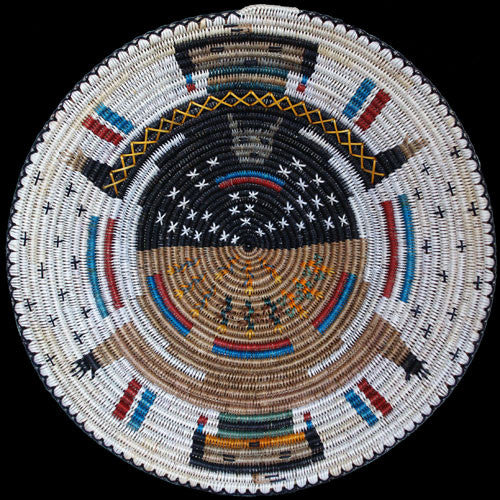
Navajo Mother Earth/Father Sky Basket - Lorraine Black (#229)
$2,500.00
Artist: Lorraine Black
Navajo Baskets
19" x 3" deep
Rounds: 33
Mother Earth and Father Sky are the two most powerful and influential deities in Navajo culture. Lorraine Yazzie Black has chosen to depict this wondrous couple in her culturally based weaving. Mother Earth is depicted in natural tones, with sacred plants upon her breast and rainbow bars placed about her being. Navajo deities travel on rainbows, so they are prevalent in this basket. Father Sky is decorated with star patterns and an image of the Moon, his alternate ego. Lorraine has finished her weaving with an attractive herringbone stitch. This dynamic duo suit each other well, the balance is complete.
We offer a 100% satisfaction guarantee on every purchase.
About the artist:

Inspired by dreams, Lorraine Black's skills have literally elevated basket weaving to new dimensions. Lorraine Black's infectious laugh belies the serious magic her hands conjure up when weaving a basket. Unprecedented in her ideas, Lorraine's baskets are innovative and beautiful. Many of them make good use of texture through over-stitching and the addition of objects such as flint arrowheads or horsehair.
See full biography
Related legends:
Mother Earth, Father Sky
I have chosen to focus on the "Mother Earth, Father Sky" sandpainting from the Male Shootingway partly because it presents the most detailed depiction of the Navajo heavens of the sandpaintings used today. In addition, since this sandpainting can only be used on the final day of the ceremonial, it embodies the Navajo concept of increase through accumulation. Chanters consider this painting to be a particularly powerful one? More about this legend
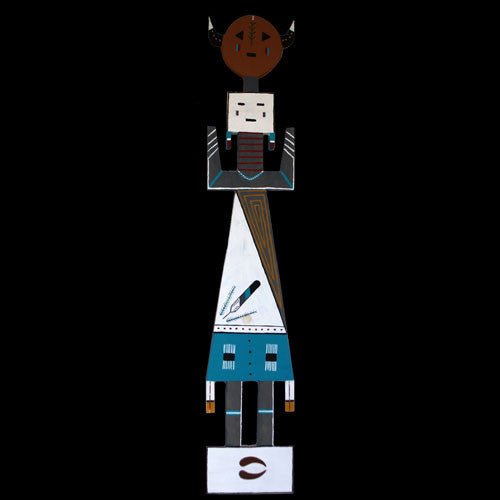
Navajo Mountain Chant Yei Carving - Harold Willeto (#30)
$250.00
Artist: Harold Willeto
Navajo Folk Art
5 1/2" x 30 1/4" x 3/4" thick
Inspired by his father, Charlie Willeto, when he came of age Navajo folk artist Harold Willeto began carving spiritual beings representing power images. This Yei is a benevolent and spiritual healer. In order to bolster the power, Harold has incorporated the footprint of a deer, prayer feathers and the face of the Sun. Harold's art is meant to portray the strength and ongoing dependability of Navajo ceremonialism and culture.
We offer a 100% satisfaction guarantee on every purchase.
About the artist:

Related legends:
Tsilkehji - Mountain Chant
There were twelve men and two women belonging to one family called N'Dohtet-leh and whose home was at Taylin (Horse Lake in the Apache country); they rode on sun dogs killing the cave dwellers in that region while the two women stayed at Taylin. Early one morning they came to Kintyel near Kayenta and found the cave dwellers holding the Eagle ceremony, and the N'Dohtet-leh killed all the Eagle dancers? More about this legend
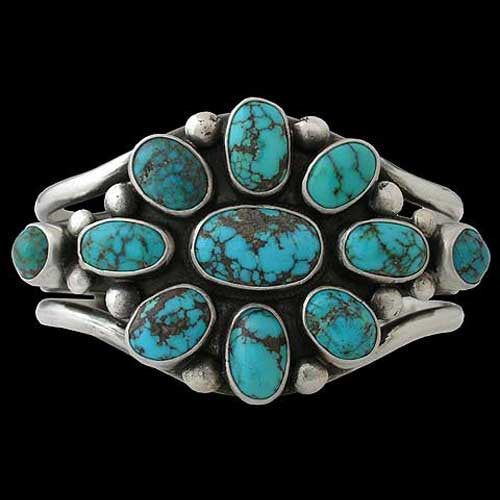
Navajo Multi Stone Persian Turquoise Bracelet - Verdy Jake (#019)
$1,200.00
Artist: Verdy Jake
Navajo Jewelry
Sterling Silver Bracelet Set with Natural Persian Turquoise
Size - 6 7/8
Inner Circumference - 5 3/8"
Opening - 1 1/2"
Center Stone - 3/8" tall x 3/4" wide
We offer a 100% satisfaction guarantee on every purchase.
Related legends:
Silversmith Work
When and how the Navajo acquired the art of working metals is unknown but there are reasons for supposing that it was introduced among them, or at least more developed and improved upon by them, since the time they have occupied their present country?

Navajo Multiple Different Natural Gem Grade Turquoise Set Ring - Tommy Jackson (#40)
$650.00
Artist: Tommy Jackson
Kingman, Tibet, Gaspiite, Manassa and Morenci Turquoise
Size: 13
Kingman
Kingman Turquoise comes from a large open-pit copper mine in the Mineral Park Mining District, northwest of Kingman, Arizona and was one of the largest turquoise mines in this country. The area lies in high desert country at an elevation of 3,345 feet and is surrounded by three mountain ranges. The mining district around Kingman, Arizona has always been a large producer of turquoise, at one time the world's largest. First mined by Indians, this area was home to the most extensive prehistoric workings found in Arizona.
The modern production of turquoise dates back to the early 1880’s when James Haas rediscovered these ancient Kingman area mines. Much of the turquoise occurred as seams, masses and veins. The color of natural Kingman turquoise can range from light blue to very dark blue and sometimes tints of green. The matrix is from white, light brown to black and frequently flecked with pyrite and times quartz. The mine became famous for its rounded, bright blue nuggets with black matrix. Few turquoise mines produced nuggets, especially of this quality. In its high-grade form it has always been considered among the top quality American turquoise. With so many thousands of pounds of good quality turquoise produced in the Kingman area over the last one hundred years it is hard to believe that today very little high-grade Kingman turquoise is available.
Other names for Kingman turquoise: Ithaca Peak, The Wall, Tiffany, Courtland, Az., Gleeson
Most desirable: Deep Blue with molybdenum pyrite; Real blue with pyrite; Bird's eye; Water Web; Nuggets
Morenci
Morenci Turquoise; Arizona Mine, Morenci, Clifton-Morenci District, Shannon Mountains, Greenlee County, Arizona, USA. An open pit copper mine located in the N1⁄2 Section 16, T4S, R29E (Clifton 15 minute topographic map), owned by Phelps Dodge Corp. Map Reference: 33°5'26"N, 109°21'58"W.
Morenci turquoise was mined in southeastern Arizona until approximately 1990. It is located very near the New Mexico border, and ranges in color from classic high electric blue to light azure. Prehistoric Indians who valued the stone for its deep blue color were the first to discover the deposit. These people adorned themselves with rough-hewn beads and carved talisman made from the mineral
Morenci is often associated with an unusual black matrix of irregular iron pyrite, which looks metallic when polished. Although they are rare, stones with unusual birds-eye patterns, red matrix and an occasional layer of silver have also been found. The Morenci name is derived from the large open pit copper mine owned and operated by the Phelps Dodge Corporation. Early examples of this striking turquoise were of the "lunch box" variety, meaning workers and miners carried them out of the mine.
Morenci is well known; it was one of the first types of American turquoise to find its way to the market and is always difficult to obtain because the mine was depleted so long ago. It is believed that the best Morenci ever produced was discovered in the late 1960's to early 70's. During this time period, the mine produced a high, electric blue variety with iron pyrite inclusions. Since Morenci is no longer being mined, and because of its striking color and unusual matrix combinations, high grade natural Morenci is a valuable, highly collectible mineral.
USGS; Arizona.--In Arizona turquoise ranks first in terms of value of production and is also the best known of its gem materials. Nearly all-important deposits of turquoise are located near copper occurrences or in copper deposits in arid desert regions of the world. Thus, the world famous turquoise deposits associated with certain of the large Arizona copper deposits are to be expected.
Turquoise is, or has been, mined from a number of these copper mines as a byproduct, usually by outside contractors. The financial and operating terms of the collecting contracts vary from mine to mine. Some of the operations are little more than the efforts of individual commercial collectors; some are essentially full-scale mining operations that are simultaneous with, but separate from, the regular mining operations; and still others operate on an on-call basis as turquoise is uncovered by the regular copper mining operation. Regardless of the size or sophistication of the initial mining or recovery operation, the actual turquoise is recovered by careful extraction using hand method.
Manassa
The King's Manassa Turquoise Mine is located east of Manassa, Colorado. From Manassa, which is 3 mi east of U.S. Highway 285, follow State Highway 142 eastward 6.6 mi; the property is located south 0.3 mi at mine dumps near the foot of a large hill. Manassa is best known for featuring turquoise of mixed greens and blues with a golden to brown colored matrix.
About the artist:
 See all items by Tommy Jackson
See all items by Tommy Jackson
Related legends:
Precious Stones
Turquoise; Precious stones have symbolic implications. For example, turquoise if a "collective term for all the precious stones, wealth, or mixed offerings. Good fortune is attributed to this stone." Both white shell and turquoise are emphasized in Kinaalda? More about this legend
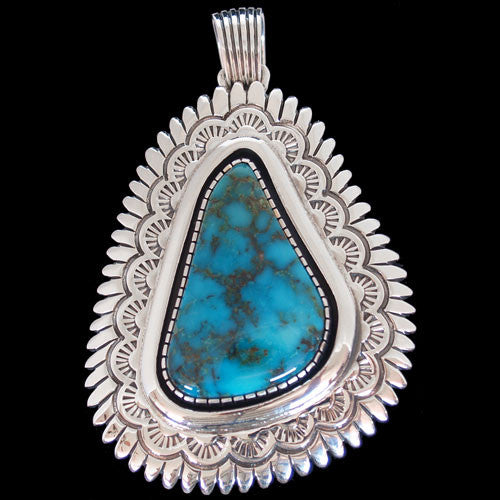
Navajo Natural Blue Gem 38cts Turquoise Pendant - Allison Lee (#194)
$2,775.00
Artist: Allison Lee
2" x 3 1/8"
Stone: 7/8" x 1 1/2"
It has taken Allison Snowhawk Lee over 40 years to achieve the level of sophistication he now has in his art. His attention to detail is, in a word, amazing, and his finish work is so crisp and squeaky clean it is hard to believe. The stamp and file work on this pendent must be examined under magnification to really appreciate it. The turquoise is super high-grade natural from the Blue Gem mine in Nevada. It is incredible. This pendent is "over the top."
Blue Gem Turquoise
Blue Gem turquoise occurs in argillized quartz monzonite cut by two limonite-stained sheer zones, one trending N 35 o W and dipping 75 o NE, the other trending N, 25 o E and dipping 55 o NW. An extensive breccia zone about 10 feet wide is developed between the two bounding sheers. Exceptionally good quality turquoise forms veins up to three-quarters of an inch thick along the shears. Pyrite-bearing quartz veins are closely associated with the turquoise.
The Blue Gem mine was at one time located deep underground, accessed by tunnels as deep as 800 feet. This is of interest because the Blue Gem Mine and the Bisbee Mine in Arizona are the only two mines (of which we are aware) that turquoise was found that deep in the earth. The Blue Gem mine was once developed in extensive underground workings and open stoops. An audit several hundred feet long on the main structure connected to numerous shorter tunnels and several open stoops. Directly above the main audit was a glory hole some 100 feet long.
Duke Goff first noted the Blue Gem deposit in 1934. It was subsequently leased from the Copper Canyon Mining Co. by the American Gem Co. of San Gabriel, CA., owned by Doc Wilson and his sons, Del and William. The company operated the property until 1941 when the outbreak of the war caused a shortage of experienced miners. Both Del and William Wilson were called into the Army for the duration of the war, and this compelled the closing of the mine. Consequently, the lease was allowed to lapse and work was abandoned. In 1950 Lee Hand and Alvin Layton of Battle Mountain leased the mine.
Production of turquoise at the Blue Gem lease in the early days of the operation was enormous. Although there is no exact information, it is reported that the output amounted to nearly
$1 million in rough turquoise. The mine is still active, although Duval Corp is currently in the center of a major copper deposit developing it.
Pyrite in Blue Gem is unusual to see but not unheard of. Very little large material ever came out of Blue Gem, the majority found was small 1-mm "bleeder" veins and tiny nuggets which was perfect for Zuni inlay and fine needlepoint, petit-point and snake-eyes jewelry. Blue Gem turquoise was very popular in the late 1930's and 40's and was commonly used in the Fred Harvey "tourist jewelry" that is so collectable today. Blue Gem turquoise is extremely hard and stands up well to the test of time.
Blue Gem turquoise is a rare, valuable and historic American treasure. Quality Blue Gem Turquoise has been gifted with a wide range and variety of color. Because Blue Gem turquoise is very hard, a high polish is associated with this stone, and unlike most turquoise, won't easily change color. This turquoise has a unique character and many different looks all of which are striking, full of wonder and pleasing to the eye.
Production of the mine started about 1934 and continued into the 1970's. Blue Gem Turquoise is still some of the finest turquoise ever found, and unlike most turquoise mines, (in which the majority mined is chalky and only usable if stabilized) most of the turquoise found there was of gem-quality. Today the Blue Gem mine is not viable; it sits in the middle of a huge mining operation. The emphasis is on precious metals and the extraction of turquoise is considered more of a hindrance in the mining process rather than an asset. Even the ever-popular "Dump Diving" for turquoise through the overburden is not tolerated due to the very real danger of becoming buried in a slide. Insurance factors, equipment hazards, high explosives and safety issues along with a lack of interest from the mining company keep Blue Gem turquoise unavailable to the world, at least for now.
About the artist:

Allison Lee - Navajo Silversmith:
Speaking of the silver and gold jewelry he hand crafts, Allison Lee's captivating voice is sincere when he says, "One time my uncle told me that everything we build comes from the earth, like the silver that comes from the earth, or the turquoise that comes from the earth. That is a lot of energy. You put it together and you put your heart and mind into a piece. Then sometimes a certain piece of jewelry- I believe- it is made for a certain person. I usually have a ring, or something, that stays with me for about two or three years, until the right person comes along. And then that person buys that piece. I believe that every piece of jewelry that I make is made for somebody out there- it's made for somebody special. Whoever might be having problems, or something like that. In essence, that energy helps that person get help, by wearing pieces that we make. That is the way I look at it.
Related legends:
Silversmith Work
When and how the Navajo acquired the art of working metals is unknown but there are reasons for supposing that it was introduced among them, or at least more developed and improved upon by them, since the time they have occupied their present country?
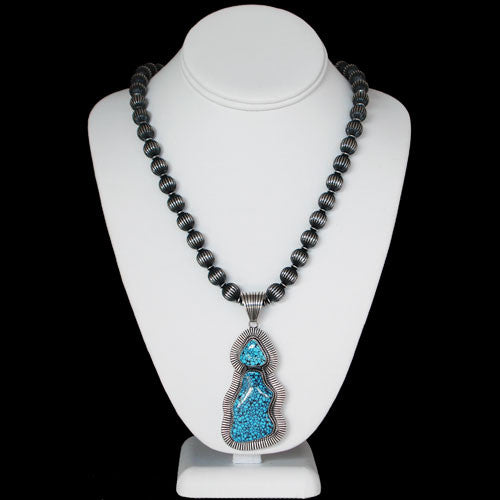
Navajo Natural Gem Grade Kingman Turquoise Necklace - Albert Jake (#59)
$2,250.00
Artist: Albert Jake
Navajo Jewelry
Necklace: 20"
Pendant: 1 1/2" x 3 1/2"
The Navajo believe turquoise was a gift of the gods, pieces of the sky dropped from above by a benevolent hand. Albert Jake discovered two of the more magnificent pieces of skystone and placed them in a setting befitting such treasures. We recognize these fabulous cabochons of high grade, natural turquoise as having come from Kingman, AZ, but who's to say for certain whether they came from heaven or earth. Albert Jake is considered a master silversmith and this pendant, best expresses, just exactly why.
We offer a 100% satisfaction guarantee on every purchase.
Kingman Turquoise
Kingman Turquoise comes from a large open-pit copper mine in the Mineral Park Mining District, northwest of Kingman, Arizona and was one of the largest turquoise mines in this country. The area lies in high desert country at an elevation of 3,345 feet and is surrounded by three mountain ranges. The mining district around Kingman, Arizona has always been a large producer of turquoise, at one time the world's largest. First mined by Indians, this area was home to the most extensive prehistoric workings found in Arizona.
The modern production of turquoise dates back to the early 1880’s when James Haas rediscovered these ancient Kingman area mines. Much of the turquoise occurred as seams, masses and veins. The color of natural Kingman turquoise can range from light blue to very dark blue and sometimes tints of green. The matrix is from white, light brown to black and frequently flecked with pyrite and times quartz. The mine became famous for its rounded, bright blue nuggets with black matrix. Few turquoise mines produced nuggets, especially of this quality. In its high-grade form it has always been considered among the top quality American turquoise. With so many thousands of pounds of good quality turquoise produced in the Kingman area over the last one hundred years it is hard to believe that today very little high-grade Kingman turquoise is available.
Other names for Kingman turquoise: Ithaca Peak, The Wall, Tiffany, Courtland, Az., Gleeson
Most desirable: Deep Blue with molybdenum pyrite; Real blue with pyrite; Bird's eye; Water Web; Nuggets
About the artist:
Since 1959, Albert Jake has made his home in the beautiful country located about forty miles south of Gallup, New Mexico. He was born at Zuni Pueblo and has resided in the village of Ramah for many years. Albert’s parent taught him the many steps to fine Navajo silverwork which includes both cluster jewelry as well as beautiful stones in classic Navajo settings.
Related legends:
Precious Stones
Turquoise; Precious stones have symbolic implications. For example, turquoise if a "collective term for all the precious stones, wealth, or mixed offerings. Good fortune is attributed to this stone." Both white shell and turquoise are emphasized in Kinaalda? More about this legend

Navajo Natural Gem Grade Morenci Turquoise Adjustable Size Ring - Albert Jake (#65)
$315.00
Artist: Albert Jake
Current Size: 7
Stone Size: .50" x .85"
Morenci Turquoise
Morenci Turquoise; Arizona Mine, Morenci, Clifton-Morenci District, Shannon Mountains, Greenlee County, Arizona, USA. An open pit copper mine located in the N1⁄2 Section 16, T4S, R29E (Clifton 15 minute topographic map), owned by Phelps Dodge Corp. Map Reference: 33°5'26"N, 109°21'58"W.
Morenci turquoise was mined in southeastern Arizona until approximately 1990. It is located very near the New Mexico border, and ranges in color from classic high electric blue to light azure. Prehistoric Indians who valued the stone for its deep blue color were the first to discover the deposit. These people adorned themselves with rough-hewn beads and carved talisman made from the mineral
Morenci is often associated with an unusual black matrix of irregular iron pyrite, which looks metallic when polished. Although they are rare, stones with unusual birds-eye patterns, red matrix and an occasional layer of silver have also been found. The Morenci name is derived from the large open pit copper mine owned and operated by the Phelps Dodge Corporation. Early examples of this striking turquoise were of the "lunch box" variety, meaning workers and miners carried them out of the mine.
Morenci is well known; it was one of the first types of American turquoise to find its way to the market and is always difficult to obtain because the mine was depleted so long ago. It is believed that the best Morenci ever produced was discovered in the late 1960's to early 70's. During this time period, the mine produced a high, electric blue variety with iron pyrite inclusions. Since Morenci is no longer being mined, and because of its striking color and unusual matrix combinations, high grade natural Morenci is a valuable, highly collectible mineral.
USGS; Arizona.--In Arizona turquoise ranks first in terms of value of production and is also the best known of its gem materials. Nearly all-important deposits of turquoise are located near copper occurrences or in copper deposits in arid desert regions of the world. Thus, the world famous turquoise deposits associated with certain of the large Arizona copper deposits are to be expected.
Turquoise is, or has been, mined from a number of these copper mines as a byproduct, usually by outside contractors. The financial and operating terms of the collecting contracts vary from mine to mine. Some of the operations are little more than the efforts of individual commercial collectors; some are essentially full-scale mining operations that are simultaneous with, but separate from, the regular mining operations; and still others operate on an on-call basis as turquoise is uncovered by the regular copper mining operation. Regardless of the size or sophistication of the initial mining or recovery operation, the actual turquoise is recovered by careful extraction using hand method.
About the artist:
Since 1959, Albert Jake has made his home in the beautiful country located about forty miles south of Gallup, New Mexico. He was born at Zuni Pueblo and has resided in the village of Ramah for many years. Albert’s parent taught him the many steps to fine Navajo silverwork which includes both cluster jewelry as well as beautiful stones in classic Navajo settings.
Related legends:
Precious Stones
Turquoise; Precious stones have symbolic implications. For example, turquoise if a "collective term for all the precious stones, wealth, or mixed offerings. Good fortune is attributed to this stone." Both white shell and turquoise are emphasized in Kinaalda? More about this legend
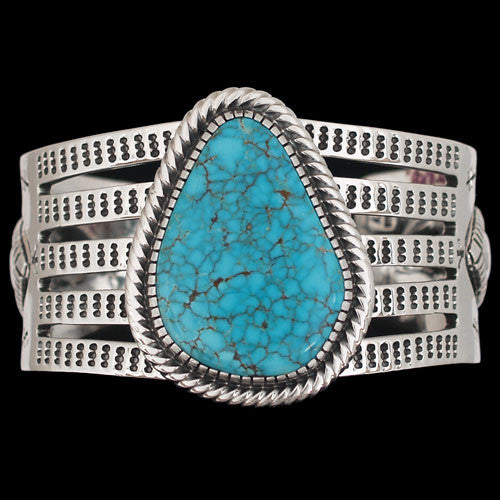
Navajo Natural Gem Grade Morenci Water-web Turquoise Bracelet - Allison Lee (#185)
$2,350.00
Artist: Allison Lee
Total inner circumference including opening: 6 1/2"
Opening: 1 1/4"
Super high-grade, natural, water-web Morenci turquoise is the centerpiece of this remarkable cuff bracelet by Navajo artist Allison Snowhawk Lee. Made in the traditional style, the bracelet is heavy, well made and unusually attractive. Allison is one of the most refined silversmiths of the modern age; his finish detail is enviable and his choice of turquoise top-drawer. When looking for collector-quality jewelry from a Native American artist, look no further than Allison Lee.
Morenci Turquoise
Morenci Turquoise; Arizona Mine, Morenci, Clifton-Morenci District, Shannon Mountains, Greenlee County, Arizona, USA. An open pit copper mine located in the N1⁄2 Section 16, T4S, R29E (Clifton 15 minute topographic map), owned by Phelps Dodge Corp. Map Reference: 33°5'26"N, 109°21'58"W.
Morenci turquoise was mined in southeastern Arizona until approximately 1990. It is located very near the New Mexico border, and ranges in color from classic high electric blue to light azure. Prehistoric Indians who valued the stone for its deep blue color were the first to discover the deposit. These people adorned themselves with rough-hewn beads and carved talisman made from the mineral
Morenci is often associated with an unusual black matrix of irregular iron pyrite, which looks metallic when polished. Although they are rare, stones with unusual birds-eye patterns, red matrix and an occasional layer of silver have also been found. The Morenci name is derived from the large open pit copper mine owned and operated by the Phelps Dodge Corporation. Early examples of this striking turquoise were of the "lunch box" variety, meaning workers and miners carried them out of the mine.
Morenci is well known; it was one of the first types of American turquoise to find its way to the market and is always difficult to obtain because the mine was depleted so long ago. It is believed that the best Morenci ever produced was discovered in the late 1960's to early 70's. During this time period, the mine produced a high, electric blue variety with iron pyrite inclusions. Since Morenci is no longer being mined, and because of its striking color and unusual matrix combinations, high grade natural Morenci is a valuable, highly collectible mineral.
USGS; Arizona.--In Arizona turquoise ranks first in terms of value of production and is also the best known of its gem materials. Nearly all-important deposits of turquoise are located near copper occurrences or in copper deposits in arid desert regions of the world. Thus, the world famous turquoise deposits associated with certain of the large Arizona copper deposits are to be expected.
Turquoise is, or has been, mined from a number of these copper mines as a byproduct, usually by outside contractors. The financial and operating terms of the collecting contracts vary from mine to mine. Some of the operations are little more than the efforts of individual commercial collectors; some are essentially full-scale mining operations that are simultaneous with, but separate from, the regular mining operations; and still others operate on an on-call basis as turquoise is uncovered by the regular copper mining operation. Regardless of the size or sophistication of the initial mining or recovery operation, the actual turquoise is recovered by careful extraction using hand method.
About the artist:

Allison Lee - Navajo Silversmith:
Speaking of the silver and gold jewelry he hand crafts, Allison Lee's captivating voice is sincere when he says, "One time my uncle told me that everything we build comes from the earth, like the silver that comes from the earth, or the turquoise that comes from the earth. That is a lot of energy. You put it together and you put your heart and mind into a piece. Then sometimes a certain piece of jewelry- I believe- it is made for a certain person. I usually have a ring, or something, that stays with me for about two or three years, until the right person comes along. And then that person buys that piece. I believe that every piece of jewelry that I make is made for somebody out there- it's made for somebody special. Whoever might be having problems, or something like that. In essence, that energy helps that person get help, by wearing pieces that we make. That is the way I look at it.
Related legends:
Silversmith Work
When and how the Navajo acquired the art of working metals is unknown but there are reasons for supposing that it was introduced among them, or at least more developed and improved upon by them, since the time they have occupied their present country?
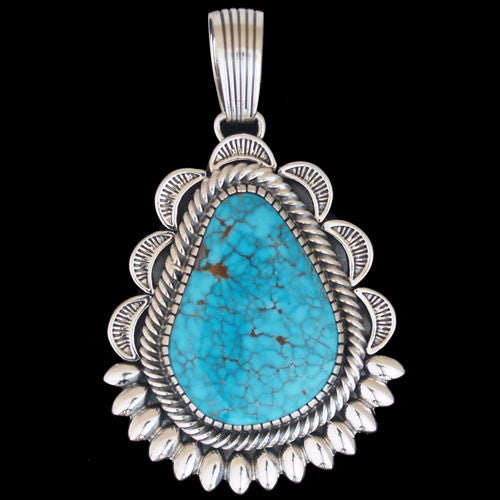
Navajo Natural Gem Grade Morenci Water-web Turquoise Pendant - Allison Lee (#184)
$1,475.00
Artist: Allison Lee
1 3/4" x 2 3/4"
Because Allison Snowhawk Lee is such a fine craftsman, he is often given access to the most precious stones. Super high-grade natural water-web Morenci turquoise is an example of such specimens, and when presented in a hand-fabricated setting by this master silversmith it becomes even dearer. Compare this stone and its setting to anything you have ever seen and you will have a benchmark for quality. Enough said.
Morenci Turquoise
Morenci Turquoise; Arizona Mine, Morenci, Clifton-Morenci District, Shannon Mountains, Greenlee County, Arizona, USA. An open pit copper mine located in the N1⁄2 Section 16, T4S, R29E (Clifton 15 minute topographic map), owned by Phelps Dodge Corp. Map Reference: 33°5'26"N, 109°21'58"W.
Morenci turquoise was mined in southeastern Arizona until approximately 1990. It is located very near the New Mexico border, and ranges in color from classic high electric blue to light azure. Prehistoric Indians who valued the stone for its deep blue color were the first to discover the deposit. These people adorned themselves with rough-hewn beads and carved talisman made from the mineral
Morenci is often associated with an unusual black matrix of irregular iron pyrite, which looks metallic when polished. Although they are rare, stones with unusual birds-eye patterns, red matrix and an occasional layer of silver have also been found. The Morenci name is derived from the large open pit copper mine owned and operated by the Phelps Dodge Corporation. Early examples of this striking turquoise were of the "lunch box" variety, meaning workers and miners carried them out of the mine.
Morenci is well known; it was one of the first types of American turquoise to find its way to the market and is always difficult to obtain because the mine was depleted so long ago. It is believed that the best Morenci ever produced was discovered in the late 1960's to early 70's. During this time period, the mine produced a high, electric blue variety with iron pyrite inclusions. Since Morenci is no longer being mined, and because of its striking color and unusual matrix combinations, high grade natural Morenci is a valuable, highly collectible mineral.
USGS; Arizona.--In Arizona turquoise ranks first in terms of value of production and is also the best known of its gem materials. Nearly all-important deposits of turquoise are located near copper occurrences or in copper deposits in arid desert regions of the world. Thus, the world famous turquoise deposits associated with certain of the large Arizona copper deposits are to be expected.
Turquoise is, or has been, mined from a number of these copper mines as a byproduct, usually by outside contractors. The financial and operating terms of the collecting contracts vary from mine to mine. Some of the operations are little more than the efforts of individual commercial collectors; some are essentially full-scale mining operations that are simultaneous with, but separate from, the regular mining operations; and still others operate on an on-call basis as turquoise is uncovered by the regular copper mining operation. Regardless of the size or sophistication of the initial mining or recovery operation, the actual turquoise is recovered by careful extraction using hand method.
About the artist:

Allison Lee - Navajo Silversmith:
Speaking of the silver and gold jewelry he hand crafts, Allison Lee's captivating voice is sincere when he says, "One time my uncle told me that everything we build comes from the earth, like the silver that comes from the earth, or the turquoise that comes from the earth. That is a lot of energy. You put it together and you put your heart and mind into a piece. Then sometimes a certain piece of jewelry- I believe- it is made for a certain person. I usually have a ring, or something, that stays with me for about two or three years, until the right person comes along. And then that person buys that piece. I believe that every piece of jewelry that I make is made for somebody out there- it's made for somebody special. Whoever might be having problems, or something like that. In essence, that energy helps that person get help, by wearing pieces that we make. That is the way I look at it.
Related legends:
Silversmith Work
When and how the Navajo acquired the art of working metals is unknown but there are reasons for supposing that it was introduced among them, or at least more developed and improved upon by them, since the time they have occupied their present country?
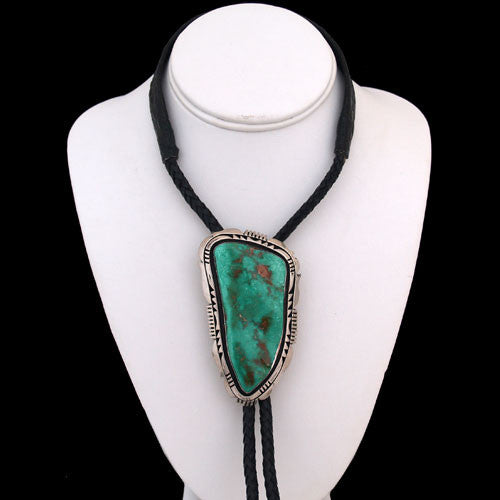
Navajo Natural Gem Grade Royston Turquoise Bolo Tie - Will Denetdale (#262)
$2,800.00
Artist: Will Denetdale
Bolo: 2" x 3 1/2"
Will Denetdale has fashioned this striking bolo tie in his classic double stack design. The fabulous cabochon of high-grade, natural Royston turquoise is cut in an appealing baroque shape that lends itself perfectly to Will's free-form style. We have had this stone many years, patiently waiting to have it set in a mounting worthy of its quality rating. When it comes to handing over prized possessions, Will is one of the few artists we give free rein. We have never been disappointed with the results of his creative process. He hand fashions jewelry for several clients, but seems happiest when precious products come across his workbench. He takes much more time and puts in a lot more effort to assure a dramatic finished product. The end result is always fabulous.
Royston Turquoise
The Royston Mining District lies on the Nye-Esmerelda County line, about 24 miles northwest of Tonopah, Nevada. In this area, turquoise mines are scattered for nearly a mile along a shallow canyon. Because it involves many small producers, the Royston district is one of the better-known turquoise mining areas in Nevada. Three of the district's more important turquoise mines are the Royal Blue, Bunker Hill and the Oscar Wehrend.
The Royal Blue mine constitutes the main turquoise workings in the district. This turquoise shows as fine-grained, altered porphyry, which is soft in places, although much of it has been hardened by silification. The turquoise is found principally in veinlets and seams, with minor lenses and nodules. The veinlets and lenses range from a fraction of an inch to more than an inch in thickness. Masses of turquoise, filling brecciated matrix, have, however, been found more than five inches thick. Lens shaped pieces of turquoise weighing an ounce or two are not uncommon, and one piece weighing nearly a pound and a half were found.
Royston turquoise ranges in color from dark and pale blue to various shades of green. Some of the dark blue turquoise has a slightly greenish cast, and some is nearly pure blue in color. The dark blue turquoise and that with a greenish cast are very fine grained and hard; the lighter colored ore is generally softer. The best turquoise is often found in limonite stained rock, and the pale blue, softer turquoise is found in light colored, softer porphyry. The quality of the best pure blue stones from the Royal Blue is equal to that found in any American mine and the matrix is especially fine.
The hard turquoise veins and nuggets are coated with a crust or stain of dark to light shading, and at times include a yellow limonite. This stain penetrates the turquoise along seams and branching cracks, producing attractive patterns and contrasts of color. Some large specimens have consisted of a patchwork of dark blue with a slightly greenish tint, marked in places with a very dark red-brown matrix. These cut gems can exhibit exceedingly wide variations of shading, and the matrix contrasts are often striking. Great spider webbing in green or blue nuggets and unusual scenic turquoise pieces are a hallmark of Royston
Two prospectors named Workman and Davis, who later sold the mine to William Petry for $3,000.00, discovered the mine in 1902. Petry improved the mine to the point of assuring its production, and, in 1907, sold it to The Himalaya Mining Co., which was owned by Julius Tannenbaum of Los Angeles and New York. Tannenbaum owned a number of mines in Nevada and California. During 1908 and 1909, the property was systematically and actively worked under the directions of Julius Goldsmith, Tanenbaum's son-in-law. Tannenbaum died suddenly about 1910, and Goldsmith hurried east to settle the estate. Shortly afterwards, he ordered operations abandoned and about 1911 sold the mine back to Petry. Petry and W. I. Miller, who had been Petry's mine boss, operated the mine for a time, and then leased it to Lee Hand and Bert Kopenhaver. Hand and Kopenhaver worked the mine dumps for a time, and then bought the mine outright from Petry. Kopenhaver later sold his share to Charley Bona. Hand and Bona worked the mine periodically, and in 1936 Bona sold his interest to Ted Johnson. In 1940 Johnson sold his share to Lee Hand.
The Otteson family now works the mine. The Otteson story began in 1944 with Lynn Otteson. Lynn brought his family to Nevada to mine turquoise and leased his first Royston claim from Lee Hand. At that time, Hand owned approximately 30 claims in the Royston district. The Otteson family has owned or leased turquoise claims in this district for the past 60 years. The Royal Blue mine has been one of the major turquoise producers in the state of Nevada. For some time, the mine produced as much as 1,250 pounds of turquoise a month, and several times has exceeded that amount.
Petry, at the time he sold the mine to Hand and Kopenhaver, declared that the Royal Blue had produced more gem quality turquoise than any mine in the United States. He placed the value of cut stones taken from the mine at more than $5 million. There is no adequate estimate of the value of gems produced from the mine in the years since that time.
The Bunker Hill is about half a mile north of The Royal Blue. In this mine, turquoise occurs in altered quartzite and ranges from royal blue to greenish blue with brown with white matrix. Turquoise is mainly in the form of slabs from 1/16 of an inch to a full inch thick. The mine was discovered in 1927 by Roy Palfreyman and Bert Kopenhaver, and was originally opened as a small shaft about 20 feet deep. As the turquoise was unearthed, the shaft was widened along the seam into a long stope, which was eventually opened into a glory hole. Polfreyman and Kopenhaver took out about $30,000 worth of turquoise, then sold to the owners of the Royal Blue mine, who produced about $75,000 worth of material. The mine eventually was incorporated into the Royal Blue group of claims.
The Oscar Wehrend mine, in the Royston district, is about 1/3 of a mile from the main workings of the Royal Blue. The turquoise is in highly altered rocks, where it forms seams, coatings and nodules as large as 2 inches thick. It is mostly soft, pale, and not of very good quality. Its color and hardness can, however, be improved by artificial means. Oscar Wehrend discovered the deposit in 1909, but Lee Hand conducted much of the work. Production from the property has been small.
The Royston Mine was originally worked as a silver mine in the late 1800s, Large deposits of high quality turquoise led Tiffany's of New York to incorporate quality green and blue turquoise stones from the Royston Hills into their jewelry lines prior to WWII. There was a brief surge of Royston turquoise production in the 1970s, and the Royston district is still producing limited amounts of high quality turquoise. The turquoise currently being produced from the Royston district is mined by Dean and Danny Otteson, and is coming from the Royal Royston claim.
About the artist:

Will Denetdale - Navajo Jewelry:
One of the most talented Navajo gold and silversmiths currently producing jewelry, Will Denetdale is making an indelible mark in the world of Native American art. His name is becoming famous in his trade; his art a standard by which other pieces may be judged. Will's success as an artist is proportionate to his devotion, and Will Denetdale lives to make jewelry.
Related legends:
Precious Stones
Turquoise; Precious stones have symbolic implications. For example, turquoise if a "collective term for all the precious stones, wealth, or mixed offerings. Good fortune is attributed to this stone." Both white shell and turquoise are emphasized in Kinaalda? More about this legend

Navajo Natural Gem Grade Spiderweb Kingman Turquoise Bracelet (#27)
$3,200.00
Turquoise Jewelry
Inner Circumference: 5 3/4"
Opening: 1 1/2"
Total: 7 1/4"
Width: 2 1/4"
Hot dang that is some nice rock. You bet it is! The turquoise in this bracelet is super high-grade natural Kingman and it is definitely way, way nice. The silver work was done sometime in the late 1960s or early '70s by an unknown Navajo silversmith. This cuff is signed with a rocking M, and stamped "Sterling" and "Navajo". The piece is of the old style, having been created of heavy silver with deeply stamped impressions. This bracelet is big and beautiful, and a bountiful example of just how extraordinary Kingman turquoise can be.
We offer a 100% satisfaction guarantee on every purchase.
Kingman Turquoise
Kingman Turquoise comes from a large open-pit copper mine in the Mineral Park Mining District, northwest of Kingman, Arizona and was one of the largest turquoise mines in this country. The area lies in high desert country at an elevation of 3,345 feet and is surrounded by three mountain ranges. The mining district around Kingman, Arizona has always been a large producer of turquoise, at one time the world's largest. First mined by Indians, this area was home to the most extensive prehistoric workings found in Arizona.
The modern production of turquoise dates back to the early 1880’s when James Haas rediscovered these ancient Kingman area mines. Much of the turquoise occurred as seams, masses and veins. The color of natural Kingman turquoise can range from light blue to very dark blue and sometimes tints of green. The matrix is from white, light brown to black and frequently flecked with pyrite and times quartz. The mine became famous for its rounded, bright blue nuggets with black matrix. Few turquoise mines produced nuggets, especially of this quality. In its high-grade form it has always been considered among the top quality American turquoise. With so many thousands of pounds of good quality turquoise produced in the Kingman area over the last one hundred years it is hard to believe that today very little high-grade Kingman turquoise is available.
Other names for Kingman turquoise: Ithaca Peak, The Wall, Tiffany, Courtland, Az., Gleeson
Most desirable: Deep Blue with molybdenum pyrite; Real blue with pyrite; Bird's eye; Water Web; Nuggets
Related legends:
Precious Stones
Turquoise; Precious stones have symbolic implications. For example, turquoise if a "collective term for all the precious stones, wealth, or mixed offerings. Good fortune is attributed to this stone." Both white shell and turquoise are emphasized in Kinaalda? More about this legend
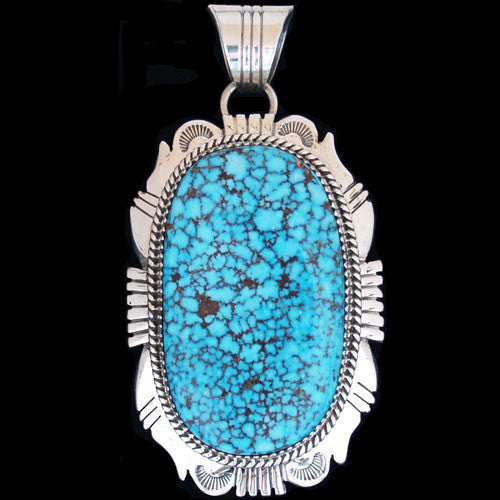
Navajo Natural Gem Grade Spiderweb Kingman Turquoise Pendant - Will Denetdale (#239)
$1,760.00
Artist: Will Denetdale
Navajo Jewelry
1 1/2" x 3"
The Kingman turquoise mine has produced hundreds of thousands of pounds of turquoise since it was first discovered. BUT! If you sorted through that production there would be less than one percent that could match the quality of this stone. Talk about high-grade, the stone in this pendent is totally natural and displays a gorgeous spider-web matrix. Will Denetdale was the obvious choice to set such a spectacular stone, his setting is clean and simple, and shows just enough silver to set-off the unique nature of the turquoise. Superb!
We offer a 100% satisfaction guarantee on every purchase.
Kingman Turquoise
Kingman Turquoise comes from a large open-pit copper mine in the Mineral Park Mining District, northwest of Kingman, Arizona and was one of the largest turquoise mines in this country. The area lies in high desert country at an elevation of 3,345 feet and is surrounded by three mountain ranges. The mining district around Kingman, Arizona has always been a large producer of turquoise, at one time the world's largest. First mined by Indians, this area was home to the most extensive prehistoric workings found in Arizona.
The modern production of turquoise dates back to the early 1880’s when James Haas rediscovered these ancient Kingman area mines. Much of the turquoise occurred as seams, masses and veins. The color of natural Kingman turquoise can range from light blue to very dark blue and sometimes tints of green. The matrix is from white, light brown to black and frequently flecked with pyrite and times quartz. The mine became famous for its rounded, bright blue nuggets with black matrix. Few turquoise mines produced nuggets, especially of this quality. In its high-grade form it has always been considered among the top quality American turquoise. With so many thousands of pounds of good quality turquoise produced in the Kingman area over the last one hundred years it is hard to believe that today very little high-grade Kingman turquoise is available.
Other names for Kingman turquoise: Ithaca Peak, The Wall, Tiffany, Courtland, Az., Gleeson
Most desirable: Deep Blue with molybdenum pyrite; Real blue with pyrite; Bird's eye; Water Web; Nuggets
About the artist:

Will Denetdale - Navajo Jewelry:
One of the most talented Navajo gold and silversmiths currently producing jewelry, Will Denetdale is making an indelible mark in the world of Native American art. His name is becoming famous in his trade; his art a standard by which other pieces may be judged. Will's success as an artist is proportionate to his devotion, and Will Denetdale lives to make jewelry.
Related legends:
Precious Stones
Turquoise; Precious stones have symbolic implications. For example, turquoise if a "collective term for all the precious stones, wealth, or mixed offerings. Good fortune is attributed to this stone." Both white shell and turquoise are emphasized in Kinaalda? More about this legend
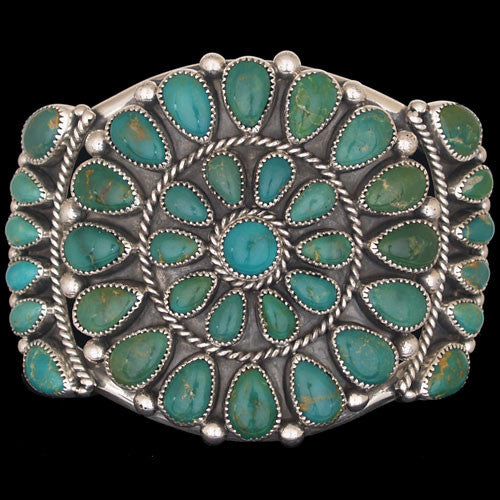
Navajo Natural Gem Grade Stone Mountain Turquoise Cluster Bracelet - Eugene Livingston (#144)
$1,850.00
Artist: Eugene Livingston
Total inner circumference including opening: 6 1/2"
Opening: 1 1/4"
Stone Mountain turquoise is quickly gaining popularity with Navajo silversmiths and turquoise dealers. The best of these stones has all the correct attributes necessary to be labeled "high-grade." Beauty, rarity and durability abound in this turquoise. Other than cutting, shaping and polishing, the stones in this bracelet are completely natural. After sorting the turquoise for color and cutting them into the correct form, Eugene Livingston took the cabochons and placed them in this old-style cluster bracelet. The outcome reflects back on cuffs created in the early days of the art and is amazing.
Stone Mountain Turquoise
Stone Mountain Mine is located in high deserts of Lyon County, Nevada. The mine was discovered in the late 1970's. The majority of the turquoise recovered from this mine is recovered by pick and shovel.
About the artist:

Eugene Livingston - Navajo Jewelry
Eugene is one of those rare artists who has mastered not just one or two methods, but a myriad of jewelry techniques. As a young man, he trained under other talented silversmiths After many decades of steady work, Eugene is skilled at metal fabrication, casting, making his own silver ingots, and most importantly for his work, the ability to cut stones. In his work below, you will see beautiful cut teardrop and pyramid cut Sleeping Beauty turquoise and coral. His two newest pieces with Carico Lake turquoise demonstrate his mastery of silver stamp work.
Related legends:
Silversmith Work
When and how the Navajo acquired the art of working metals is unknown but there are reasons for supposing that it was introduced among them, or at least more developed and improved upon by them, since the time they have occupied their present country?
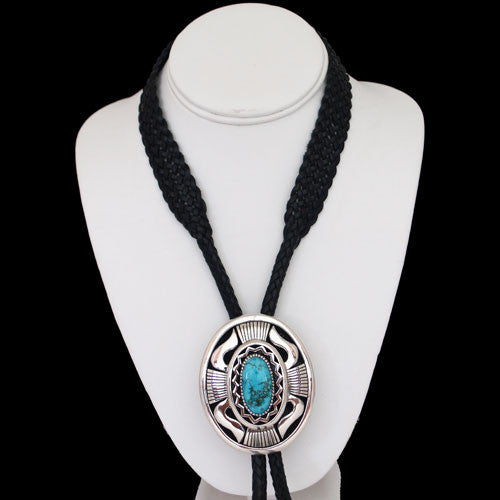
Navajo Natural High Gem Grade Blue Gem Turquoise Bolo Tie - Allison Lee (#191)
$3,200.00
Artist: Allison Lee
Bolo: 2 3/8" x 2 7/8"
Stone: .58" x 1.22"
Strap: 44"
Allison Lee is surely one of the most talented silversmiths we have ever run into. When you connect him with turquoise from Barry’s private reserve; well, the result is, as you see, SPECTACULAR. Sorry for shouting, but this oval piece of high-grade Blue Gem fits right into Allison’s carved and stamped Ketoh design. It is a rare individual who can fabricate bolo ties of this quality. Both Allison and his jewelry are extraordinary.
Blue Gem Turquoise
Blue Gem turquoise occurs in argillized quartz monzonite cut by two limonite-stained sheer zones, one trending N 35 o W and dipping 75 o NE, the other trending N, 25 o E and dipping 55 o NW. An extensive breccia zone about 10 feet wide is developed between the two bounding sheers. Exceptionally good quality turquoise forms veins up to three-quarters of an inch thick along the shears. Pyrite-bearing quartz veins are closely associated with the turquoise.
The Blue Gem mine was at one time located deep underground, accessed by tunnels as deep as 800 feet. This is of interest because the Blue Gem Mine and the Bisbee Mine in Arizona are the only two mines (of which we are aware) that turquoise was found that deep in the earth. The Blue Gem mine was once developed in extensive underground workings and open stoops. An audit several hundred feet long on the main structure connected to numerous shorter tunnels and several open stoops. Directly above the main audit was a glory hole some 100 feet long.
Duke Goff first noted the Blue Gem deposit in 1934. It was subsequently leased from the Copper Canyon Mining Co. by the American Gem Co. of San Gabriel, CA., owned by Doc Wilson and his sons, Del and William. The company operated the property until 1941 when the outbreak of the war caused a shortage of experienced miners. Both Del and William Wilson were called into the Army for the duration of the war, and this compelled the closing of the mine. Consequently, the lease was allowed to lapse and work was abandoned. In 1950 Lee Hand and Alvin Layton of Battle Mountain leased the mine.
Production of turquoise at the Blue Gem lease in the early days of the operation was enormous. Although there is no exact information, it is reported that the output amounted to nearly
$1 million in rough turquoise. The mine is still active, although Duval Corp is currently in the center of a major copper deposit developing it.
Pyrite in Blue Gem is unusual to see but not unheard of. Very little large material ever came out of Blue Gem, the majority found was small 1-mm "bleeder" veins and tiny nuggets which was perfect for Zuni inlay and fine needlepoint, petit-point and snake-eyes jewelry. Blue Gem turquoise was very popular in the late 1930's and 40's and was commonly used in the Fred Harvey "tourist jewelry" that is so collectable today. Blue Gem turquoise is extremely hard and stands up well to the test of time.
Blue Gem turquoise is a rare, valuable and historic American treasure. Quality Blue Gem Turquoise has been gifted with a wide range and variety of color. Because Blue Gem turquoise is very hard, a high polish is associated with this stone, and unlike most turquoise, won't easily change color. This turquoise has a unique character and many different looks all of which are striking, full of wonder and pleasing to the eye.
Production of the mine started about 1934 and continued into the 1970's. Blue Gem Turquoise is still some of the finest turquoise ever found, and unlike most turquoise mines, (in which the majority mined is chalky and only usable if stabilized) most of the turquoise found there was of gem-quality. Today the Blue Gem mine is not viable; it sits in the middle of a huge mining operation. The emphasis is on precious metals and the extraction of turquoise is considered more of a hindrance in the mining process rather than an asset. Even the ever-popular "Dump Diving" for turquoise through the overburden is not tolerated due to the very real danger of becoming buried in a slide. Insurance factors, equipment hazards, high explosives and safety issues along with a lack of interest from the mining company keep Blue Gem turquoise unavailable to the world, at least for now.
About the artist:

Allison Lee - Navajo Silversmith:
Speaking of the silver and gold jewelry he hand crafts, Allison Lee's captivating voice is sincere when he says, "One time my uncle told me that everything we build comes from the earth, like the silver that comes from the earth, or the turquoise that comes from the earth. That is a lot of energy. You put it together and you put your heart and mind into a piece. Then sometimes a certain piece of jewelry- I believe- it is made for a certain person. I usually have a ring, or something, that stays with me for about two or three years, until the right person comes along. And then that person buys that piece. I believe that every piece of jewelry that I make is made for somebody out there- it's made for somebody special. Whoever might be having problems, or something like that. In essence, that energy helps that person get help, by wearing pieces that we make. That is the way I look at it.
Related legends:
Precious Stones
Turquoise; Precious stones have symbolic implications. For example, turquoise if a "collective term for all the precious stones, wealth, or mixed offerings. Good fortune is attributed to this stone." Both white shell and turquoise are emphasized in Kinaalda? More about this legend

Navajo Natural High Grade Kingman Turquoise Adjustable Ring - Albert Jake (#66)
$375.00
Artist: Albert Jake
Current Size: 8
Kingman Turquoise
Kingman Turquoise comes from a large open-pit copper mine in the Mineral Park Mining District, northwest of Kingman, Arizona and was one of the largest turquoise mines in this country. The area lies in high desert country at an elevation of 3,345 feet and is surrounded by three mountain ranges. The mining district around Kingman, Arizona has always been a large producer of turquoise, at one time the world's largest. First mined by Indians, this area was home to the most extensive prehistoric workings found in Arizona.
The modern production of turquoise dates back to the early 1880’s when James Haas rediscovered these ancient Kingman area mines. Much of the turquoise occurred as seams, masses and veins. The color of natural Kingman turquoise can range from light blue to very dark blue and sometimes tints of green. The matrix is from white, light brown to black and frequently flecked with pyrite and times quartz. The mine became famous for its rounded, bright blue nuggets with black matrix. Few turquoise mines produced nuggets, especially of this quality. In its high-grade form it has always been considered among the top quality American turquoise. With so many thousands of pounds of good quality turquoise produced in the Kingman area over the last one hundred years it is hard to believe that today very little high-grade Kingman turquoise is available.
Other names for Kingman turquoise: Ithaca Peak, The Wall, Tiffany, Courtland, Az., Gleeson
Most desirable: Deep Blue with molybdenum pyrite; Real blue with pyrite; Bird's eye; Water Web; Nuggets
About the artist:
Since 1959, Albert Jake has made his home in the beautiful country located about forty miles south of Gallup, New Mexico. He was born at Zuni Pueblo and has resided in the village of Ramah for many years. Albert’s parent taught him the many steps to fine Navajo silverwork which includes both cluster jewelry as well as beautiful stones in classic Navajo settings.
Related legends:
Precious Stones
Turquoise; Precious stones have symbolic implications. For example, turquoise if a "collective term for all the precious stones, wealth, or mixed offerings. Good fortune is attributed to this stone." Both white shell and turquoise are emphasized in Kinaalda? More about this legend

Navajo Natural Sleeping Beauty Turquoise Brooch - Eugene Livingston (#138)
$495.00
Artist: Eugene Livingston
Navajo Jewelry
2" x 2"
This eye-catching broach is of the cluster style. Navajo silversmith Eugene Livingston hand cuts each and every turquoise stone to exacting detail, creates the mounting of sterling silver, sets the stones then polishes the whole thing to a lustrous shine. The finished product is one of Eugene's trademark centerpieces. High grade, natural Sleeping Beauty turquoise from Globe, Az. is this master craftsman's turquoise of choice.
We offer a 100% satisfaction guarantee on every purchase.
Sleeping Beauty Turquoise
The Sleeping Beauty turquoise mine is located seven miles from Globe, Arizona. The mine is one of the largest producers of turquoise in North America. The mine, and the turquoise extracted from it, derives its name from Sleeping Beauty Mountain, which at one time was part of the Copper Cities operation. The center of the copper mine is located at approximately 33o24"13.23"N. 110o53'34. 60"W, at an elevation of 1224 feet. Sleeping Beauty Turquoise Mining is presently owned and operated by Monty Nichols.
For many centuries before the first Europeans made their way into Arizona, turquoise was being mined on the slopes of Sleeping Beauty Mountain. The Salado and other ancient peoples mined the beautiful sky stone from several surface outcroppings located in the vicinity, including Pinto Valley. It is believed that Spanish explorers were the first Europeans to locate the source of Sleeping Beauty sometime around the 1860s. By the 1870s, small underground mines pockmarked the hills surrounding present day Globe.
Cities Service Company started the Copper Cities Mine (commonly called the Sleeping Beauty Mine) in 1952 and operated it until the Pinto Valley mine opened in 1972. During the 1960s, L.W. Hardy had the contract to mine turquoise, both at Sleeping Beauty and at Castle Dome, later called the Pinto Valley Mine. Formerly a meat cutter at a market in Miami, Hardy recognized early on that turquoise was more valuable as a gemstone than the associated copper.
By the time the turquoise boom began, Hardy had contracts with mining companies in Miami, Kingman and elsewhere. He also developed a method for stabilizing low-grade, porous turquoise with pressure-impregnated hot acrylic resin, which hardened the stone and improved the color.
Hardy's mining methods were primitive when compared with current operations. Hardy's workers sat in a ditch ripped by a bulldozer and hand picked the stone from waste-rock. Hardy mined turquoise at Sleeping Beauty for 22 years, getting about 45 percent recovery, and leaving the rest in waste dumps.
Monty Nichols received the contract to mine Sleeping Beauty turquoise in 1988, and began using modern mining methods to develop the property. Nichols drills and blasts the overburden, hauling it to the abandoned Copper Cities pit, which now contains the recycled tailings from Miami Copper Company's No. 5 tailing dam. The old dam dominated the eastern skyline of downtown Miami until recently. The year Nichols acquired the contract; he began a two-year project to remove 5,000.000 tons of overburden. Located half way up the side of an open pit mine, the narrow turquoise-bearing zone has about 400 feet of hard waste rock on top of it. In order to move sideways into the ore-body, a whole slice of the mountain had to be removed.
To avoid fracturing the turquoise, Nichols was careful not to blast too near the turquoise-bearing strata. That layer is more crumbly, so the miners can rip it and dump it over screens, separating the material by size. No crushers are used, again to avoid fracturing the gemstone, and the different sized rock is hauled up to a wide mine bench where conveyor belts move the material through three buildings. There, workers handpick turquoise from the broken rock. The buildings are vented with filtered air to eliminate workers' exposure to dust, and well insulated to keep them comfortable in any weather. It is a far cry from the old methods of mining. Anywhere from 30 to 40 people work at the mine at any one time, depending on how much mining there is to do.
Fifty years ago, mine workers filled lunch buckets with the colorful rock, even though it was reason for immediate termination. Old habits die hard, and some people still think it is okay to sneak in and try to pick turquoise. As a result, security is tight in and around the mine. Motion detectors, night vision cameras and 24/7 roving patrols are used, so the only turquoise leaving the property now is being shipped to markets around the world.
Italy is the largest volume buyer of Sleeping Beauty turquoise, with Germany and Hong Kong following closely behind. These customers buy the best grade for their exclusive jewelry. Jewelry makers in India and Spain also receive Sleeping Beauty turquoise, while in the U.S., Gallup and Albuquerque are the largest consumers.
The Sleeping Beauty turquoise mine produces a uniform light to medium blue turquoise with rare finds of deep, dark blue. Because of its uniformity, it has been a favorite of the Zuni Pueblo. Zuni silversmiths often use it in channel inlay and various types of cluster work that require large numbers of small, perfectly matched stones. The Sleeping Beauty mine has been one of the larger producers of rough turquoise in the United States, although today much less good turquoise is being produced than in the past.
Sleeping Beauty turquoise is noted for its solid, light blue color with no matrix; the host rock is usually granite. Nichols says the mine is producing about 1,600 pounds a month. Of that, only four percent is natural; most of the turquoise from the mine is altered in some way. Most is enhanced, which is more expensive than stabilization, and sold to large distributors in this country and Europe. Currently most of the turquoise that comes from the mine is from the tons of tailings piles that have been accumulating for decades.
The best of the Sleeping Beauty turquoise is comparable to that found in the Middle East. It is thought that large quantities of Sleeping Beauty turquoise is taken overseas and smuggled into, then out of, Iran to be sold as “Persian” turquoise.
About the artist:

Eugene Livingston - Navajo Jewelry
Eugene is one of those rare artists who has mastered not just one or two methods, but a myriad of jewelry techniques. As a young man, he trained under other talented silversmiths After many decades of steady work, Eugene is skilled at metal fabrication, casting, making his own silver ingots, and most importantly for his work, the ability to cut stones. In his work below, you will see beautiful cut teardrop and pyramid cut Sleeping Beauty turquoise and coral. His two newest pieces with Carico Lake turquoise demonstrate his mastery of silver stamp work.
Related legends:
Precious Stones
Turquoise; Precious stones have symbolic implications. For example, turquoise if a "collective term for all the precious stones, wealth, or mixed offerings. Good fortune is attributed to this stone." Both white shell and turquoise are emphasized in Kinaalda? More about this legend
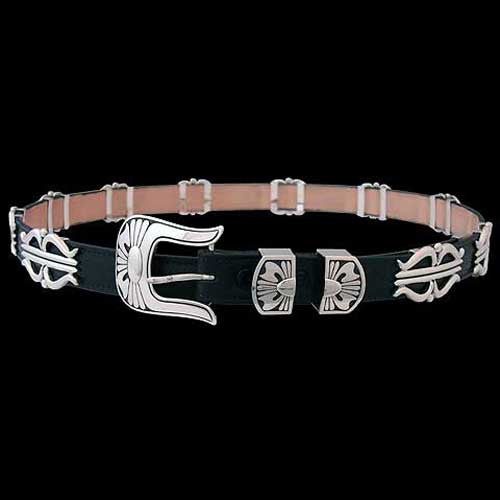
Navajo Overlay Belt & Sand Cast Conchos - Allison Snowhawk Lee #054
$2,750.00
Artist: Allison Snowhawk Lee
About the artist:

Allison Lee - Navajo Silversmith:
Speaking of the silver and gold jewelry he hand crafts, Allison Lee's captivating voice is sincere when he says, "One time my uncle told me that everything we build comes from the earth, like the silver that comes from the earth, or the turquoise that comes from the earth. That is a lot of energy. You put it together and you put your heart and mind into a piece. Then sometimes a certain piece of jewelry- I believe- it is made for a certain person. I usually have a ring, or something, that stays with me for about two or three years, until the right person comes along. And then that person buys that piece. I believe that every piece of jewelry that I make is made for somebody out there- it's made for somebody special. Whoever might be having problems, or something like that. In essence, that energy helps that person get help, by wearing pieces that we make. That is the way I look at it.
Related legends:
Silversmith Work
When and how the Navajo acquired the art of working metals is unknown but there are reasons for supposing that it was introduced among them, or at least more developed and improved upon by them, since the time they have occupied their present country?
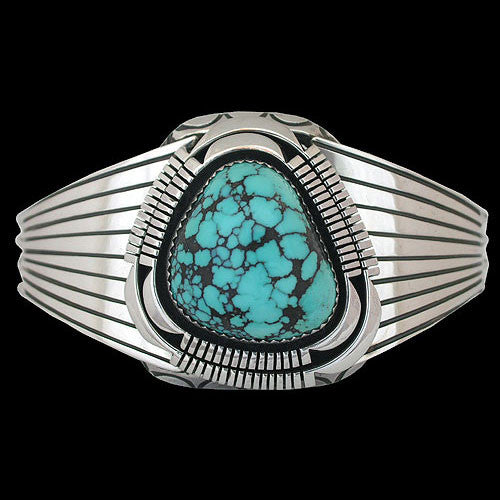
Navajo Overlay Bracelet with Burnham Turquoise - Toby Henderson (#076)
$1,200.00
Artist: Toby Henderson
Navajo Jewelry
Hand Stamped Sterling Silver Overlay Bracelet set with Natural Burnham Turquoise
Size - 7 3/4
Inner Circumference - 5 7/8"
Opening - 1 7/8"
Stone - 3/4" wide x 1" tall
We offer a 100% satisfaction guarantee on every purchase.
About the artist:

Toby Henderson was born and raised in Phoenix, Arizona. The roots of his family tree are buried deep in the Borrego Pass area of the Navajo Reservation in New Mexico. Toby's mother Ella Long, his grandparents, Helen and Jim Long, and his Uncle Phillip Long, and Tommy Long are all silver and gold smiths recognized for high quality and innovative workmanship. Toby learned his art from his grandparents with whom he spent the summer months when he was a young boy. Toby recalls that his Grandparents were patient and inspiring instructors. They were pleased that he was carrying on the family silversmith tradition. Toby's work can be described as both traditional and contemporary, he has a special fondness for hand crafted, three-dimensional, sterling silver kachinas and Yei-be-chei figures. Toby was the first in his family to create these freestanding Holy People figures. With his daughters and son Toby keeps the family tradition alive. The boy and girls help with everything from design to buffing and polishing.
Related legends:
Silversmith Work
When and how the Navajo acquired the art of working metals is unknown but there are reasons for supposing that it was introduced among them, or at least more developed and improved upon by them, since the time they have occupied their present country?
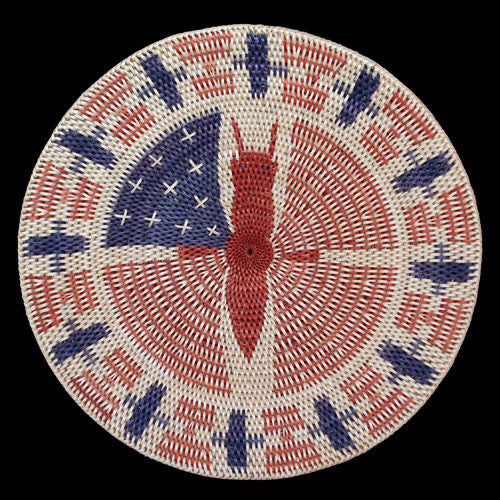
Navajo Patriotic Butterfly Basket - Elsie Holiday (#070)
$1,900.00
Artist: Elsie Holiday
Navajo Baskets
Patriotic Butterfly
15"
We offer a 100% satisfaction guarantee on every purchase.
About the artist:

Considered one of the best Navajo basket weavers, Elsie Stone Holiday married into the famed Douglas Mesa family of weavers. Weaving baskets has become almost an addiction for her. "When I go two or three days without weaving I get anxious to get started again," she says. She weaves 12 hours a day, 5 days a week. "Sometimes I think, 'How long can this last?'", she wistfully states, but for now she is content with her art, finding immense satisfaction in creating premier quality baskets.
Related legends:
Butterfly in Navajo Traditional Stories
Butterfly: Due to the natural beauty of its wings, Butterfly is often considered vain. Yet, in Navajo mythology, Butterfly brings the sacred flint to the hooves of the horse. In the legend of the diety, Butterfly Boy was cured of his vanity by being lightning struck with the axe of Rain Boy. After that, his head opened up and out of it came the butterflies of the world. The perishable dust of Butterfly's wings is sometimes thought to prove that such beauty is usually not durable.
Weaving
After the medicine woman told the people about the prayersticks she told them that there was a place in the underworld where two rivers crossed. It was called ni tqin'kae tsosi, fine fiber cotton (Indian hemp). There were two persons who brought the seed of that plant, they were spiders. They said that the people were to use the plant instead of skins for their clothing. So this seed was planted in the earth? More about this legend
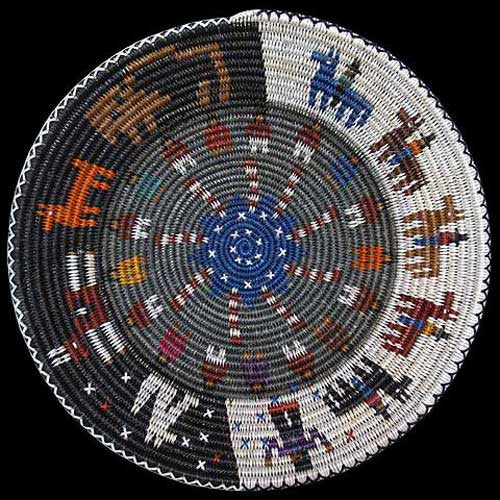
Navajo Patriotic Symbolism Pictorial Basket - Peggy Black (#299)
$2,500.00
Artist: Peggy Black
Navajo Baskets
18 1/2" x 3 1/2" deep
Rounds: 33
Peggy Rock Black's Collage basket is a whole lot of fun and fantasy all wrapped-up in one finely woven package. Through the creative process, Peggy instructs us how First Man and Coyote placed the constellations and Milky Way in the heavens. She introduces us to the riders of the Enemy Way, the Home of the Buffalo People, sacred ceremony, balance, harmony and much, much more. Through the art of Navajo basketry, Peggy uses pictorial images as a way of promoting tradition and culture.
We offer a 100% satisfaction guarantee on every purchase.
About the artist:

One of the famous Douglas Mesa basket weavers, there wasn't much question about what Peggy Rock Black would choose to pursue in life. She was born into a family of weavers before she married into an equally talented family of weavers.
Related legends:
Horse
Johano-ai starts each day from his hogan, in the east, and rides across the skies to his hogan in the west, carrying the shining golden disk, the sun. He has five horses a horse of turquoise, a horse of white shell, a horse of pearl shell, a horse of red shell, and a horse of coal? More about this legend
People/Diversity
Big Star makes peace between them with instructions that neither should return to the wife and the admonition that there will always be different kinds of people in the world snake, coyote, star people and that "they must make the best of it."? More about this legend
Symbolism
The hoop ceremonies of the Navajo have been compared by anthropologists to mandalas, Paleolithic sunwheels, or "magic circles." Spruce, willow, and other hoops represent the four passages of man through the four elemental worlds. They are also symbolic of the four directions, the four sacred mountains, the four-cornered construct of the human family mother, father, son, daughter and the four stages of human life? More about this legend
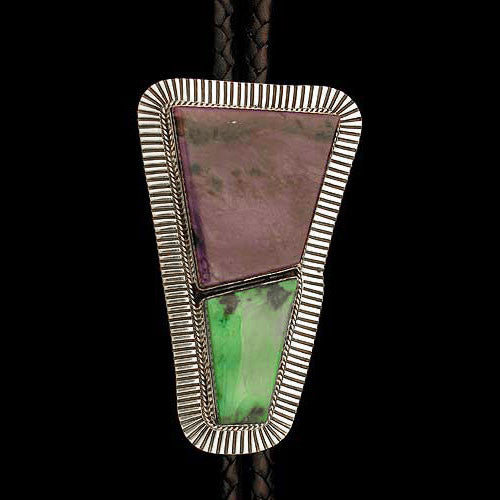
Navajo Persian Turquoise and Sugilite Bolo Tie - Albert Jake (#023)
$2,100.00
Artist: Albert Jake
Navajo Jewelry
Persian Turquoise & Sugilite set in
Sterling Silver Slide on
Purple Leather Bolo Tie
Slide: 1 7/8" x 3"
Bolo: 48" long
Albert Jake decided to take a hunk of sugilite and a hunk of Persian turquoise and make a contemporary bolo tie that is timeless in its design. Albert knows you don’t want to complicate the silver work when you have stones like this. He has therefore used clean, simple stamping and a foundational shape to show off his skills. Very nice indeed.
We offer a 100% satisfaction guarantee on every purchase.
Persian Turquoise
In the Southwest, we tend to take turquoise for granted; yet it has been labeled the “Gemstone of the Centuries”. Over 7,500 years ago, slave convoys were sent into the Sinai Peninsula to pluck pieces of the blue gem from the rocks where it had formed. In ancient Egypt, turquoise was believed to have mystical powers and appeared in amulets and talisman representing their gods Amum and Isis. A gold and carved turquoise bracelet was found on the mummified arm of Queen Zer, a ruler during the first dynasty of Egyptian pharaohs. The four bracelets found in her burial are the earliest known examples of precious metal jewelry.
The Middle East emerged as the great purveyor of turquoise, supplying the ancient Egyptians, Nubians, Greeks and Romans. It is believed the name was derived from the French word, Turquie, a reference to the Turkish traders first bringing the rich blue stones to the European continent. It was assumed that the brilliant blue and green stones originated in Turkey when, in fact, they were most likely extracted from mines in the Sinai Peninsula and the Alimersai Mountain in Persia (Iran).
About the artist:
Since 1959, Albert Jake has made his home in the beautiful country located about forty miles south of Gallup, New Mexico. He was born at Zuni Pueblo and has resided in the village of Ramah for many years. Albert’s parent taught him the many steps to fine Navajo silverwork which includes both cluster jewelry as well as beautiful stones in classic Navajo settings.
Related legends:
Silversmith Work
When and how the Navajo acquired the art of working metals is unknown but there are reasons for supposing that it was introduced among them, or at least more developed and improved upon by them, since the time they have occupied their present country?

Navajo Persian Turquoise Bracelet - Derrick Gordon (#20)
$700.00
Artist: Derrick Gordon
Navajo Jewelry
Inner Circumference: 5"
Opening: 1"
Total: 6"
Width: 1 1/4"
Turquoise has deep roots in the Southwest. Many people, however, do not realize that turquoise has an even deeper foundation in Persia. This brilliantly green stone chosen by Derrick Gordon comes from the boarder lands of what we currently call Iran. It is handsomely set in a burnished cuff, bringing out its history and color. Derrick knows how to showcase fabulous stones. See what we mean!
We offer a 100% satisfaction guarantee on every purchase.
Persian Turquoise
In the Southwest, we tend to take turquoise for granted; yet it has been labeled the “Gemstone of the Centuries”. Over 7,500 years ago, slave convoys were sent into the Sinai Peninsula to pluck pieces of the blue gem from the rocks where it had formed. In ancient Egypt, turquoise was believed to have mystical powers and appeared in amulets and talisman representing their gods Amum and Isis. A gold and carved turquoise bracelet was found on the mummified arm of Queen Zer, a ruler during the first dynasty of Egyptian pharaohs. The four bracelets found in her burial are the earliest known examples of precious metal jewelry.
The Middle East emerged as the great purveyor of turquoise, supplying the ancient Egyptians, Nubians, Greeks and Romans. It is believed the name was derived from the French word, Turquie, a reference to the Turkish traders first bringing the rich blue stones to the European continent. It was assumed that the brilliant blue and green stones originated in Turkey when, in fact, they were most likely extracted from mines in the Sinai Peninsula and the Alimersai Mountain in Persia (Iran).
About the artist:
At the age of nineteen, Derrick Gordon sat down at the bench with his uncle, Delbert Gordon, and a promising new career was launched. Derrick was born and raised in Gallup, New Mexico. He came into this world in 1971, but it was not until 1990 that he began to bless us with his unique style of Navajo silver jewelry.
Related legends:
Precious Stones
Turquoise; Precious stones have symbolic implications. For example, turquoise if a "collective term for all the precious stones, wealth, or mixed offerings. Good fortune is attributed to this stone." Both white shell and turquoise are emphasized in Kinaalda? More about this legend
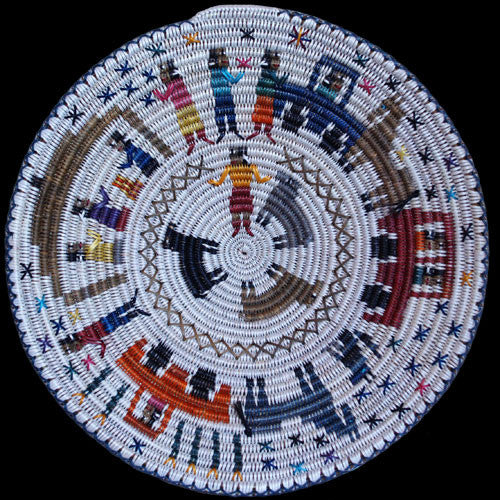
Navajo Pictorial Basket - Lorraine Black (#225)
$1,995.00
Artist: Lorraine Black
Navajo Baskets
16 1/2" x 2 1/2" deep
Rounds: 30
Lorraine Black has proven herself to be one of the best Navajo basket weavers of all time. Through her art, Lorraine is recognized for her interpretations of Navajo family life and ceremony. This particular basket portrays a typical lifestyle scene that could be found almost anywhere in Navajoland. Transportation is a big issue on the Rez, so horses and vehicles are well represented. Social interaction and a healthy herd of sheep are also important to the people. For a storyboard of everyday life in Dinetah, one needs to look to Lorraine for inspiration.
We offer a 100% satisfaction guarantee on every purchase.
About the artist:

Inspired by dreams, Lorraine Black's skills have literally elevated basket weaving to new dimensions. Lorraine Black's infectious laugh belies the serious magic her hands conjure up when weaving a basket. Unprecedented in her ideas, Lorraine's baskets are innovative and beautiful. Many of them make good use of texture through over-stitching and the addition of objects such as flint arrowheads or horsehair.
Related legends:
Bear
The bear was the next chief to be called. He was given a name but he was not satisfied. He became so angry that First Man used the word "shash" to quiet him. The bear repeated it four times, and he said that it had a strange sound, and when one said it aloud one had and awesome feeling. So he went off well content that "shash" should be his name.

Navajo Pictorial Twin Rocks Rug - Eleanor Yazzie (#112)
$495.00
Artist: Eleanor Yazzie
Navajo Rugs
31" x 37"
Carnelda Benally and her well-known mother, Eleanor Yazzie, have chosen the iconic Twin Rocks as the theme for one of their pictorial rugs. Symbolizing the Navajo Hero Twins, Monster-slayer and Born-for-Water, these monuments have monumental meaning. Don’t miss out on this one-of-a-kind weaving. They’ll never be another one like it.
We offer a 100% satisfaction guarantee on every purchase.
About the artist:

Eleanor was born in 1963 at Keams Canyon, Arizona to Joe and Ella Benally. She has two sisters and five brothers. When visiting her grandmother on her mother's side who lived at Smoke Signal, she would watch her weave. Her grandmother, Bah Begay, especially loved weaving storm pattern rugs. Eleanor helped her grandmother who, at that time, made handspun rugs. Eleanor learned every step from shearing the sheep to washing and dyeing the wool to spinning the yarn. Because her grandmother especially loved the storm pattern weavings, this style was the first type woven by Eleanor. Her mastery of complex geometrics and diagonal lines comes from this experience in weaving the storm pattern.
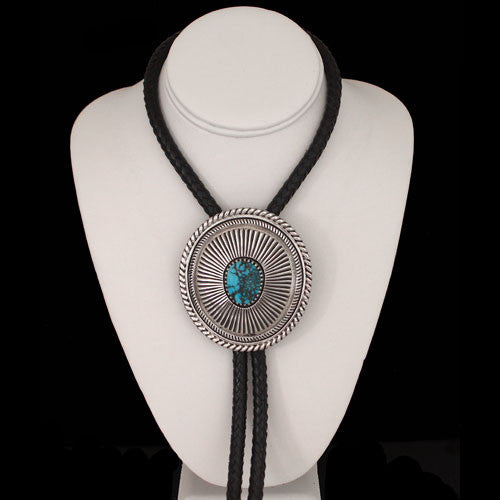
Navajo Pilot Mountain Turquoise 22.15 ct Bolo Tie - Allison Lee (#177)
$3,500.00
Artist: Allison Lee
Navajo Jewelry
Bolo: 2 3/4" x 3"
Strap: 46" long
Allison Lee, great stamping, exquisite execution, Pilot Mountain turquoise, sterling silver! What can we say? Oh yea, great price.
We offer a 100% satisfaction guarantee on every purchase.
About the artist:

Allison Lee - Navajo Silversmith:
Speaking of the silver and gold jewelry he hand crafts, Allison Lee's captivating voice is sincere when he says, "One time my uncle told me that everything we build comes from the earth, like the silver that comes from the earth, or the turquoise that comes from the earth. That is a lot of energy. You put it together and you put your heart and mind into a piece. Then sometimes a certain piece of jewelry- I believe- it is made for a certain person. I usually have a ring, or something, that stays with me for about two or three years, until the right person comes along. And then that person buys that piece. I believe that every piece of jewelry that I make is made for somebody out there- it's made for somebody special. Whoever might be having problems, or something like that. In essence, that energy helps that person get help, by wearing pieces that we make. That is the way I look at it.
Related legends:
Silversmith Work
When and how the Navajo acquired the art of working metals is unknown but there are reasons for supposing that it was introduced among them, or at least more developed and improved upon by them, since the time they have occupied their present country?

Navajo Police Bull Dog Wood Carving - Marvin Jim (#365)
$695.00
Artist: Marvin Jim
Folk Art
Base: 4 1/2" x 4 1/2"
Height: 15"
We offer a 100% satisfaction guarantee on every purchase.
About the artist:

Marvin Jim - Animal Sculptures:
Based upon the Navajo creation tales, the sculptures of Marvin Jim reflect a time long ago, when animals and humans walked and worked together to create a new world. These traditional stories speak of conversations among all beings, of behaving in a manner of mutual respect and of all beings having an equal position in the community. These legends are an essential part of the Navajo culture. The tales are of universal interaction, compassion and tolerance; the things necessary to live a balanced existence.

Navajo Polychrome Dream Basket - Elsie Holiday (#407)
$3,975.00
Artist: Elsie Holiday
Navajo Basket
21 1/2" x 5" deep
Rounds: 34
Elsie Holiday has created a dream of a basket in her latest “Dream Basket”. Taking one of her classic designs and adding a bit of red, she has gone from monotone to polychrome in the stitch of the hand. Never one to shy away from difficult designs, Elsie has mastered all aspects of contemporary Navajo basketry. A master she surely has become.
We offer a 100% satisfaction guarantee on every purchase.
About the artist:

Considered one of the best Navajo basket weavers, Elsie Stone Holiday married into the famed Douglas Mesa family of weavers. Weaving baskets has become almost an addiction for her. "When I go two or three days without weaving I get anxious to get started again," she says. She weaves 12 hours a day, 5 days a week. "Sometimes I think, 'How long can this last?'", she wistfully states, but for now she is content with her art, finding immense satisfaction in creating premier quality baskets.
Related legends:
Navajo Basketry
Basketry is a woman's industry, which is also pursued by the nadle (he changes), hermaphrodites, or men skilled in the arts and industries of both men and women. Basketry, however, is not classified with textile fabrics (yistl'o), but with sewing (nalkhad). It is of interest also that, while the basket is in progress, the sewer is untouched and avoided by the members of her family?
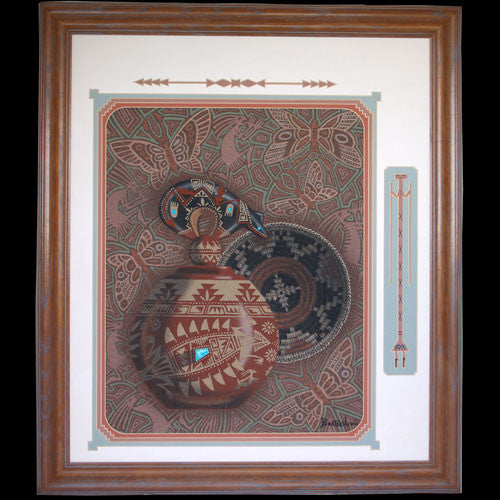
Navajo Pottery, Bear and Basket Sandpainting - Eugene B. Joe (#08)
$1,500.00
Artist: Eugene B. Joe
Folk Art
Frame: 25 1/2" x 29 1/2"
Sandpainting: 15 1/2" x 19 1/2"
Eugene “Baatsoslanii" Joe is one of the all-time great Navajo sand painters. Early in his career he developed an intricate, contemporary style that distinguished him from all the others and spawned many copycats. Eugene’s work, however, is the standard. Carved pottery, Navajo ceremonial baskets, fetish animals and bits of natural gem grade turquoise are surrounded by complex butterflies, dancing Kokopelli’s and other finely detailed motifs. Eugene is the best.
We offer a 100% satisfaction guarantee on every purchase.
About the artist:

Navajo Artist
Related legends:
Sandpainting
The gods' sandpaintings are kept on deerskin or on sheets of sky or naska rather than being made new in sand each time. The picture cannot be given in this form to men who are not as "good" as the gods; "They might quarrel over the picture and tear it, and that would bring misfortune; the black cloud would not come again, the rain would not fall; the corn would not grow."? More about this legend

Navajo Rainbow Basket - Joann Johnson (#118)
$2,750.00
Artist: Joann Johnson
19" across x 3 1/2" deep
Rounds: 36
Joann Johnson is all about color; the color she sees every day living in Monument Valley by way of rainbows, the color of her heritage, and the color of the people inhabiting her world. Taking all these influences and blending them together in her basketry results in an explosion of creativity and cultural beauty. Joann is one of the best contemporary Navajo basket weavers and her weavings are a joy to own.
About the artist:

A fourth generation Navajo basket weaver, Joann Johnson has a passionate awareness of her heritage and history. Born and raised in Monument Valley, she has spent her life in the Navajo heartland, surrounded by the sacred mountains and monuments that tell the stories of her people's past.
Related legends:
Colors
Color, an outstanding symbol of Navaho ceremonialism, is especially significant in combination, but first I discuss the more general aspects of each color in the order in which they most commonly occur. No color or sequence runs through a single chant consistently; none has the same meaning in every setting, nor does chance account for apparent exceptions to the rules; every detail is calculated. If there seems to be a variation, it is for cause?

Navajo Rainbow Man Basket - Elsie Holiday (#419)
$2,750.00
Artist: Elsie Holiday
15 1/2" x 17 1/4" x 3" deep
Rounds: 24
Elsie Holiday is constantly probing the outer envelope of creativity. That is, of course, the reason her baskets are so innovative. Super weaving aside, she has an extremely active imagination. Just take a look at “Rainbow Man” and you will readily agree there is no other contemporary Navajo basket maker who does work like this.
About the artist:

Considered one of the best Navajo basket weavers, Elsie Stone Holiday married into the famed Douglas Mesa family of weavers. Weaving baskets has become almost an addiction for her. "When I go two or three days without weaving I get anxious to get started again," she says. She weaves 12 hours a day, 5 days a week. "Sometimes I think, 'How long can this last?'", she wistfully states, but for now she is content with her art, finding immense satisfaction in creating premier quality baskets.
See full biography | See all items by Elsie Holiday
Related legends:
Rainbow People
Straight Rainbow People are pictured in a few sandpaintings of Mountainway Shooting Branch, Nightway, Big Godway, and Upward-reachingway. They do not differ from representations of People in general, except that they have red and blue bodies. Bent, curved, or Whirling Rainbow People are found in sandpaintings for Beautyway, male Shootingway, Nightway, Mountainway, and male Plumeway. This last one shows four Rainbow People with their bodies curved not quite to a right angle, something like the eight slightly curved Rainbow People of Beautyway? More about this legend

Navajo Rectangular Chinese Turquoise Stone Silver Bracelet (#07)
$490.00
Navajo Jewelry
Hand Stamped Sterling Silver Bracelet set with One Rectangular Chinese Turquoise Stone
Size - 6 3/4
Inner Circumference - 5 5/8"
Opening - 1 1/4"
We offer a 100% satisfaction guarantee on every purchase.
Related legends:
Silversmith Work
When and how the Navajo acquired the art of working metals is unknown but there are reasons for supposing that it was introduced among them, or at least more developed and improved upon by them, since the time they have occupied their present country?
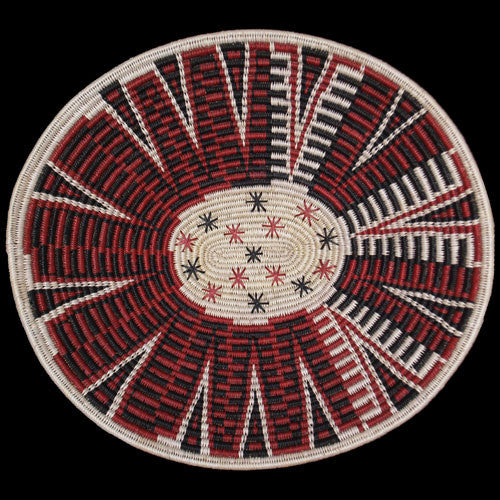
Navajo Red Canyon Basket - Chris Johnson (#45)
$2,495.00
Artist: Chris Johnson
Navajo Basket
16 3/4" x 18 1/2" x 2" deep
Rounds: 32
Red Canyon is the latest basket by Navajo weaver Chris Johnson. As always, his work is tight and fine. The abstract design of this weaving speaks of the canyons of his homeland and the skills he has developed over many long years. You can never go wrong collecting Chris’ basketry.
We offer a 100% satisfaction guarantee on every purchase.
About the artist:

Related legends:
Wickerwork
The carrying basket is even less frequently seen than the water jar. tsizis (tsi, hair, and zis, or azis, a bag or pouch, from the mode of carrying it over the hair of the forehead) is used at present for gathering the hashkan, or yucca fruit, for syrup. The baskets are plaited of willow twigs much after the style of our own baskets, but have neither handle nor finished rim? More about this legend

Navajo Red Mesa Outline Rug - Ruby Coggeshell (#45)
$2,250.00
Artist: Ruby Coggeshell
Navajo Rugs
40" x 53"
Black and white, positive and negative. Ruby Coggeshell has woven a rug of opposites. The beauty of this rug is almost mind-boggling in its monochrome coloration. It reminds us of the landscape that surrounds and enfolds us. It’s simple, stark, and staggering. You will love this rug in your home.
We offer a 100% satisfaction guarantee on every purchase.
About the artist:

When Ruby Coggeshell was a small child she would sit and watch with fascination as her mother wove intricate and colorful Red Mesa Style rugs. She also watched her two aunts and their daughters. As she watched their strong hands working the wool she would ask questions. "I've always liked to listen to the stories," she says, "About when they were young, what it was like. I always asked questions. They usually would tell me."
Related legends:
Red Mesa Rugs

Navajo Red Mesa Rug - Ruby Coggeshell (#52)
$935.00
Artist: Ruby Coggeshell
33 1/2" x 27"
Before treading upon the primitive mesas and monuments of Red Mesa, the Hero Twins had never been bested. That, however, was before they ran into one of the most magnificent of all entities, the female. Not knowing what he was getting into, Monster slayer attempted to destroy what he interpreted as a foe. He took a terrible licking, and barely made it home to his mama. When her son retold the tale of his thrashing, his mother laughed out loud. "What you have encountered my son is that which cannot be defeated; female energy." That was exactly what Ruby Coggeshell depicted when she wove her Red Mesa rug. She too gets a kick out of the story. As with Changing Woman, it makes her laugh to think about such an impossible undertaking.
About the artist:

When Ruby Coggeshell was a small child she would sit and watch with fascination as her mother wove intricate and colorful Red Mesa Style rugs. She also watched her two aunts and their daughters. As she watched their strong hands working the wool she would ask questions. "I've always liked to listen to the stories," she says, "About when they were young, what it was like. I always asked questions. They usually would tell me."

Navajo Revival Weaving - Gloria Begay (#01)
$1,800.00
Artist: Gloria Begay
Navajo Rugs
Revival
23" x 21"
This tightly woven rug by Gloria C. Begay is made in the classic style. Influenced by First and Second Phase Chief Blanket weavings of the Navajo, the deep reds and blues speak of long ago when the Navajo freely roamed the Southwest. Times may change, but traditions endure. Gloria has taken the time to weave a beautiful weaving that will last generations. Even your grandchildren will charish this rug.
We offer a 100% satisfaction guarantee on every purchase.
Related legends:
Weaving
After the medicine woman told the people about the prayersticks she told them that there was a place in the underworld where two rivers crossed. It was called ni tqin'kae tsosi, fine fiber cotton (Indian hemp). There were two persons who brought the seed of that plant, they were spiders. They said that the people were to use the plant instead of skins for their clothing. So this seed was planted in the earth? More about this legend
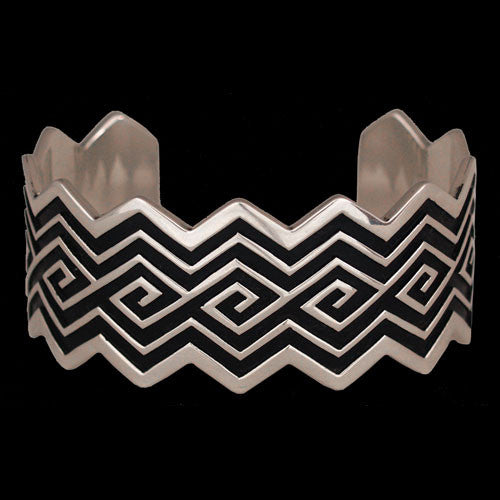
Navajo River Bracelet - Ray Scott (#04)
$950.00
Artist: Ray Scott
Navajo Jewelry
Total Circumference: 6 1/2"
Inner Circumference: 5 1/4"
Opening: 1 1/4"
Pooling, eddying, swirling water, that is what Ray Scott had in mind when he crafted this stunning sterling silver cuff. In the desert, water is sacred, and Ray’s bracelet exemplifies and celebrates this primary element. Ray is known for designing and executing clean and uncomplicated works of art and this is one is at once contemporary and timeless. Get it before the flood of calls start.
We offer a 100% satisfaction guarantee on every purchase.
Related legends:
Silversmith Work
When and how the Navajo acquired the art of working metals is unknown but there are reasons for supposing that it was introduced among them, or at least more developed and improved upon by them, since the time they have occupied their present country?

Navajo Round Eye Dazzler Rug - Rolanda Begay (#02)
$330.00
Artist: Rolanda Begay
Navajo Rug
18" x 19"
Circles inspire us to think about how our world is interconnected; everything affects everything. In this circular rug by Rolanda Begay, you can imagine any number of stories about relationships, the environment and our world in general. Inspiring.
We offer a 100% satisfaction guarantee on every purchase.

Navajo Royston Turquoise and Sterling Silver Concho Belt (#48)
$1,800.00
Turquoise Jewelry
54" long
The 1960's were a great time for Navajo jewelry, but not so good for recognizing the artist. This Concho belt has a hallmark on the back of the buckle, but it is not definitive enough to tell us who the artist was. So often we see superb artwork without a hallmark. Such a thing was mostly not thought of back then. This very appealing concho belt is a perfect example of that occurrence. The workmanship is that of a master silversmith and his taste in turquoise was top shelf. Who ever he or she was, we pay them tribute today by presenting their art with a heartfelt "Thank you!"
We offer a 100% satisfaction guarantee on every purchase.
Royston Turquoise
The Royston Mining District lies on the Nye-Esmerelda County line, about 24 miles northwest of Tonopah, Nevada. In this area, turquoise mines are scattered for nearly a mile along a shallow canyon. Because it involves many small producers, the Royston district is one of the better-known turquoise mining areas in Nevada. Three of the district's more important turquoise mines are the Royal Blue, Bunker Hill and the Oscar Wehrend.
The Royal Blue mine constitutes the main turquoise workings in the district. This turquoise shows as fine-grained, altered porphyry, which is soft in places, although much of it has been hardened by silification. The turquoise is found principally in veinlets and seams, with minor lenses and nodules. The veinlets and lenses range from a fraction of an inch to more than an inch in thickness. Masses of turquoise, filling brecciated matrix, have, however, been found more than five inches thick. Lens shaped pieces of turquoise weighing an ounce or two are not uncommon, and one piece weighing nearly a pound and a half were found.
Royston turquoise ranges in color from dark and pale blue to various shades of green. Some of the dark blue turquoise has a slightly greenish cast, and some is nearly pure blue in color. The dark blue turquoise and that with a greenish cast are very fine grained and hard; the lighter colored ore is generally softer. The best turquoise is often found in limonite stained rock, and the pale blue, softer turquoise is found in light colored, softer porphyry. The quality of the best pure blue stones from the Royal Blue is equal to that found in any American mine and the matrix is especially fine.
The hard turquoise veins and nuggets are coated with a crust or stain of dark to light shading, and at times include a yellow limonite. This stain penetrates the turquoise along seams and branching cracks, producing attractive patterns and contrasts of color. Some large specimens have consisted of a patchwork of dark blue with a slightly greenish tint, marked in places with a very dark red-brown matrix. These cut gems can exhibit exceedingly wide variations of shading, and the matrix contrasts are often striking. Great spider webbing in green or blue nuggets and unusual scenic turquoise pieces are a hallmark of Royston
Two prospectors named Workman and Davis, who later sold the mine to William Petry for $3,000.00, discovered the mine in 1902. Petry improved the mine to the point of assuring its production, and, in 1907, sold it to The Himalaya Mining Co., which was owned by Julius Tannenbaum of Los Angeles and New York. Tannenbaum owned a number of mines in Nevada and California. During 1908 and 1909, the property was systematically and actively worked under the directions of Julius Goldsmith, Tanenbaum's son-in-law. Tannenbaum died suddenly about 1910, and Goldsmith hurried east to settle the estate. Shortly afterwards, he ordered operations abandoned and about 1911 sold the mine back to Petry. Petry and W. I. Miller, who had been Petry's mine boss, operated the mine for a time, and then leased it to Lee Hand and Bert Kopenhaver. Hand and Kopenhaver worked the mine dumps for a time, and then bought the mine outright from Petry. Kopenhaver later sold his share to Charley Bona. Hand and Bona worked the mine periodically, and in 1936 Bona sold his interest to Ted Johnson. In 1940 Johnson sold his share to Lee Hand.
The Otteson family now works the mine. The Otteson story began in 1944 with Lynn Otteson. Lynn brought his family to Nevada to mine turquoise and leased his first Royston claim from Lee Hand. At that time, Hand owned approximately 30 claims in the Royston district. The Otteson family has owned or leased turquoise claims in this district for the past 60 years. The Royal Blue mine has been one of the major turquoise producers in the state of Nevada. For some time, the mine produced as much as 1,250 pounds of turquoise a month, and several times has exceeded that amount.
Petry, at the time he sold the mine to Hand and Kopenhaver, declared that the Royal Blue had produced more gem quality turquoise than any mine in the United States. He placed the value of cut stones taken from the mine at more than $5 million. There is no adequate estimate of the value of gems produced from the mine in the years since that time.
The Bunker Hill is about half a mile north of The Royal Blue. In this mine, turquoise occurs in altered quartzite and ranges from royal blue to greenish blue with brown with white matrix. Turquoise is mainly in the form of slabs from 1/16 of an inch to a full inch thick. The mine was discovered in 1927 by Roy Palfreyman and Bert Kopenhaver, and was originally opened as a small shaft about 20 feet deep. As the turquoise was unearthed, the shaft was widened along the seam into a long stope, which was eventually opened into a glory hole. Polfreyman and Kopenhaver took out about $30,000 worth of turquoise, then sold to the owners of the Royal Blue mine, who produced about $75,000 worth of material. The mine eventually was incorporated into the Royal Blue group of claims.
The Oscar Wehrend mine, in the Royston district, is about 1/3 of a mile from the main workings of the Royal Blue. The turquoise is in highly altered rocks, where it forms seams, coatings and nodules as large as 2 inches thick. It is mostly soft, pale, and not of very good quality. Its color and hardness can, however, be improved by artificial means. Oscar Wehrend discovered the deposit in 1909, but Lee Hand conducted much of the work. Production from the property has been small.
The Royston Mine was originally worked as a silver mine in the late 1800s, Large deposits of high quality turquoise led Tiffany's of New York to incorporate quality green and blue turquoise stones from the Royston Hills into their jewelry lines prior to WWII. There was a brief surge of Royston turquoise production in the 1970s, and the Royston district is still producing limited amounts of high quality turquoise. The turquoise currently being produced from the Royston district is mined by Dean and Danny Otteson, and is coming from the Royal Royston claim.
Related legends:
Silversmith Work
When and how the Navajo acquired the art of working metals is unknown but there are reasons for supposing that it was introduced among them, or at least more developed and improved upon by them, since the time they have occupied their present country?
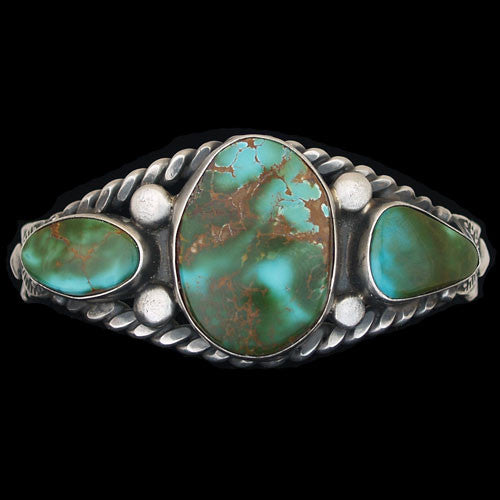
Navajo Royston Turquoise Sterling Silver Bracelet - Victor Begay (#33)
$2,495.00
Artist: Victor Begay
Navajo Jewelry
Inner Circumference: 5"
Opening: 1"
Total: 6"
Width: 1 1/4"
When it comes to Royston turquoise character is the name of the game, and this cuff, featuring a suite of three smashing character stones, shines like a beacon. Navajo silversmith Victor Begay knew not to get too complex with the metalwork and left the stones to stand on their own. Surely the crowds will hover when they see you wearing this.
We offer a 100% satisfaction guarantee on every purchase.
Royston Turquoise
The Royston Mining District lies on the Nye-Esmerelda County line, about 24 miles northwest of Tonopah, Nevada. In this area, turquoise mines are scattered for nearly a mile along a shallow canyon. Because it involves many small producers, the Royston district is one of the better-known turquoise mining areas in Nevada. Three of the district's more important turquoise mines are the Royal Blue, Bunker Hill and the Oscar Wehrend.
The Royal Blue mine constitutes the main turquoise workings in the district. This turquoise shows as fine-grained, altered porphyry, which is soft in places, although much of it has been hardened by silification. The turquoise is found principally in veinlets and seams, with minor lenses and nodules. The veinlets and lenses range from a fraction of an inch to more than an inch in thickness. Masses of turquoise, filling brecciated matrix, have, however, been found more than five inches thick. Lens shaped pieces of turquoise weighing an ounce or two are not uncommon, and one piece weighing nearly a pound and a half were found.
Royston turquoise ranges in color from dark and pale blue to various shades of green. Some of the dark blue turquoise has a slightly greenish cast, and some is nearly pure blue in color. The dark blue turquoise and that with a greenish cast are very fine grained and hard; the lighter colored ore is generally softer. The best turquoise is often found in limonite stained rock, and the pale blue, softer turquoise is found in light colored, softer porphyry. The quality of the best pure blue stones from the Royal Blue is equal to that found in any American mine and the matrix is especially fine.
The hard turquoise veins and nuggets are coated with a crust or stain of dark to light shading, and at times include a yellow limonite. This stain penetrates the turquoise along seams and branching cracks, producing attractive patterns and contrasts of color. Some large specimens have consisted of a patchwork of dark blue with a slightly greenish tint, marked in places with a very dark red-brown matrix. These cut gems can exhibit exceedingly wide variations of shading, and the matrix contrasts are often striking. Great spider webbing in green or blue nuggets and unusual scenic turquoise pieces are a hallmark of Royston
Two prospectors named Workman and Davis, who later sold the mine to William Petry for $3,000.00, discovered the mine in 1902. Petry improved the mine to the point of assuring its production, and, in 1907, sold it to The Himalaya Mining Co., which was owned by Julius Tannenbaum of Los Angeles and New York. Tannenbaum owned a number of mines in Nevada and California. During 1908 and 1909, the property was systematically and actively worked under the directions of Julius Goldsmith, Tanenbaum's son-in-law. Tannenbaum died suddenly about 1910, and Goldsmith hurried east to settle the estate. Shortly afterwards, he ordered operations abandoned and about 1911 sold the mine back to Petry. Petry and W. I. Miller, who had been Petry's mine boss, operated the mine for a time, and then leased it to Lee Hand and Bert Kopenhaver. Hand and Kopenhaver worked the mine dumps for a time, and then bought the mine outright from Petry. Kopenhaver later sold his share to Charley Bona. Hand and Bona worked the mine periodically, and in 1936 Bona sold his interest to Ted Johnson. In 1940 Johnson sold his share to Lee Hand.
The Otteson family now works the mine. The Otteson story began in 1944 with Lynn Otteson. Lynn brought his family to Nevada to mine turquoise and leased his first Royston claim from Lee Hand. At that time, Hand owned approximately 30 claims in the Royston district. The Otteson family has owned or leased turquoise claims in this district for the past 60 years. The Royal Blue mine has been one of the major turquoise producers in the state of Nevada. For some time, the mine produced as much as 1,250 pounds of turquoise a month, and several times has exceeded that amount.
Petry, at the time he sold the mine to Hand and Kopenhaver, declared that the Royal Blue had produced more gem quality turquoise than any mine in the United States. He placed the value of cut stones taken from the mine at more than $5 million. There is no adequate estimate of the value of gems produced from the mine in the years since that time.
The Bunker Hill is about half a mile north of The Royal Blue. In this mine, turquoise occurs in altered quartzite and ranges from royal blue to greenish blue with brown with white matrix. Turquoise is mainly in the form of slabs from 1/16 of an inch to a full inch thick. The mine was discovered in 1927 by Roy Palfreyman and Bert Kopenhaver, and was originally opened as a small shaft about 20 feet deep. As the turquoise was unearthed, the shaft was widened along the seam into a long stope, which was eventually opened into a glory hole. Polfreyman and Kopenhaver took out about $30,000 worth of turquoise, then sold to the owners of the Royal Blue mine, who produced about $75,000 worth of material. The mine eventually was incorporated into the Royal Blue group of claims.
The Oscar Wehrend mine, in the Royston district, is about 1/3 of a mile from the main workings of the Royal Blue. The turquoise is in highly altered rocks, where it forms seams, coatings and nodules as large as 2 inches thick. It is mostly soft, pale, and not of very good quality. Its color and hardness can, however, be improved by artificial means. Oscar Wehrend discovered the deposit in 1909, but Lee Hand conducted much of the work. Production from the property has been small.
The Royston Mine was originally worked as a silver mine in the late 1800s, Large deposits of high quality turquoise led Tiffany's of New York to incorporate quality green and blue turquoise stones from the Royston Hills into their jewelry lines prior to WWII. There was a brief surge of Royston turquoise production in the 1970s, and the Royston district is still producing limited amounts of high quality turquoise. The turquoise currently being produced from the Royston district is mined by Dean and Danny Otteson, and is coming from the Royal Royston claim.
Related legends:
Precious Stones
Turquoise; Precious stones have symbolic implications. For example, turquoise if a "collective term for all the precious stones, wealth, or mixed offerings. Good fortune is attributed to this stone." Both white shell and turquoise are emphasized in Kinaalda? More about this legend
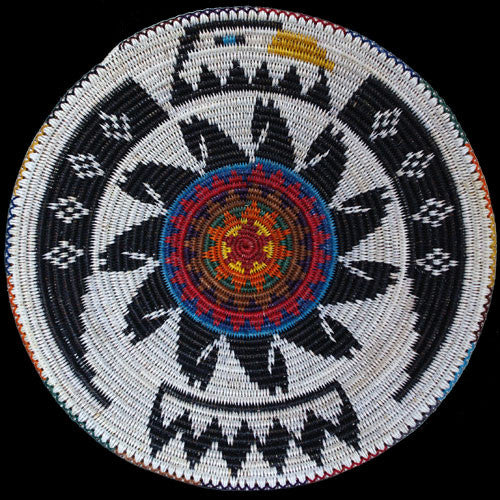
Navajo Sacred Animals Basket - Peggy Black (#384)
$2,700.00
Artist: Peggy Black
Navajo Baskets
20 1/2" x 3" deep
Rounds: 35
Peggy Rock Black has woven a most interesting and graphically attractive basket. The central colors represent home fires and the emergence or awakening of consciousness. There is a blue ring for sacred waters and horse heads over that which portrays freedom and independence. The grace and majesty of the Eagle encircle and protect all that is cherished and sacred. A rainbow wraps around the outside edge of the basket adding one extra layer of protection. Beautiful!
We offer a 100% satisfaction guarantee on every purchase.
About the artist:

One of the famous Douglas Mesa basket weavers, there wasn't much question about what Peggy Rock Black would choose to pursue in life. She was born into a family of weavers before she married into an equally talented family of weavers.
See full biography | See all items by Peggy Black
Related legends:
Eagle
Of all birds in Native American mythology, the eagle is the most important as symbol, sacrificial / ceremonial presence, and ultimate predator/ warrior. The solitary mystery and power of the eagle as perceived by the Indian was immediately grasped by the emerging nation of the United States, and "borrowed" for its logo. More about this legend
Horse
Johano-ai starts each day from his hogan, in the east, and rides across the skies to his hogan in the west, carrying the shining golden disk, the sun. He has five horses a horse of turquoise, a horse of white shell, a horse of pearl shell, a horse of red shell, and a horse of coal? More about this legend
